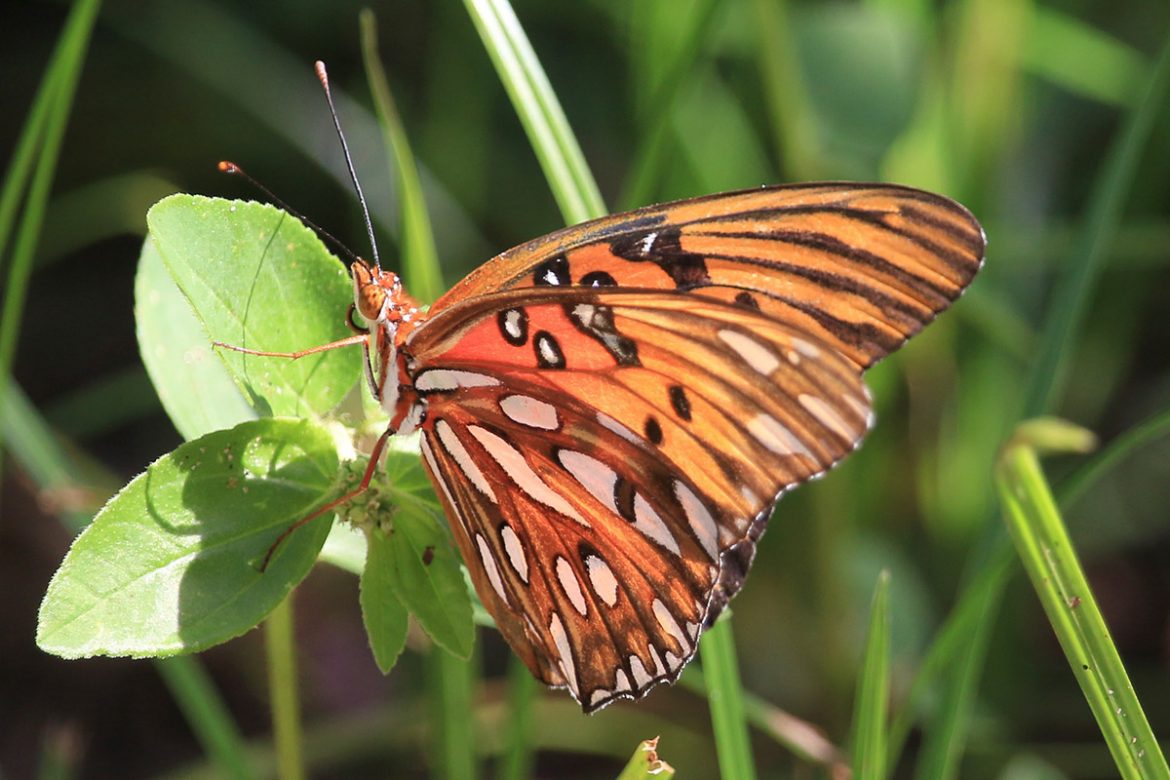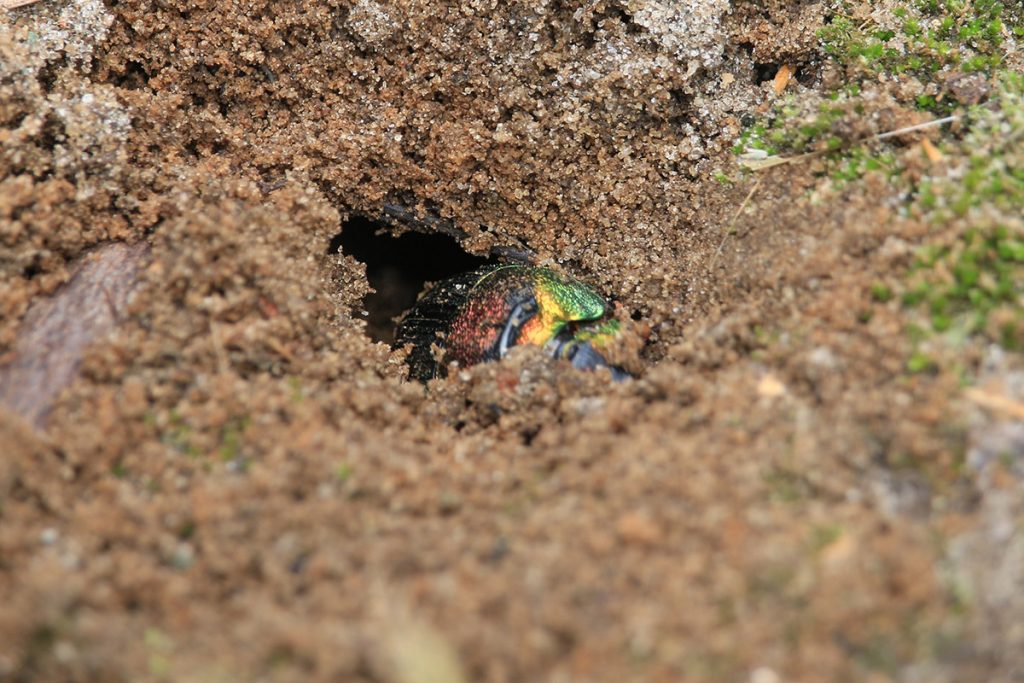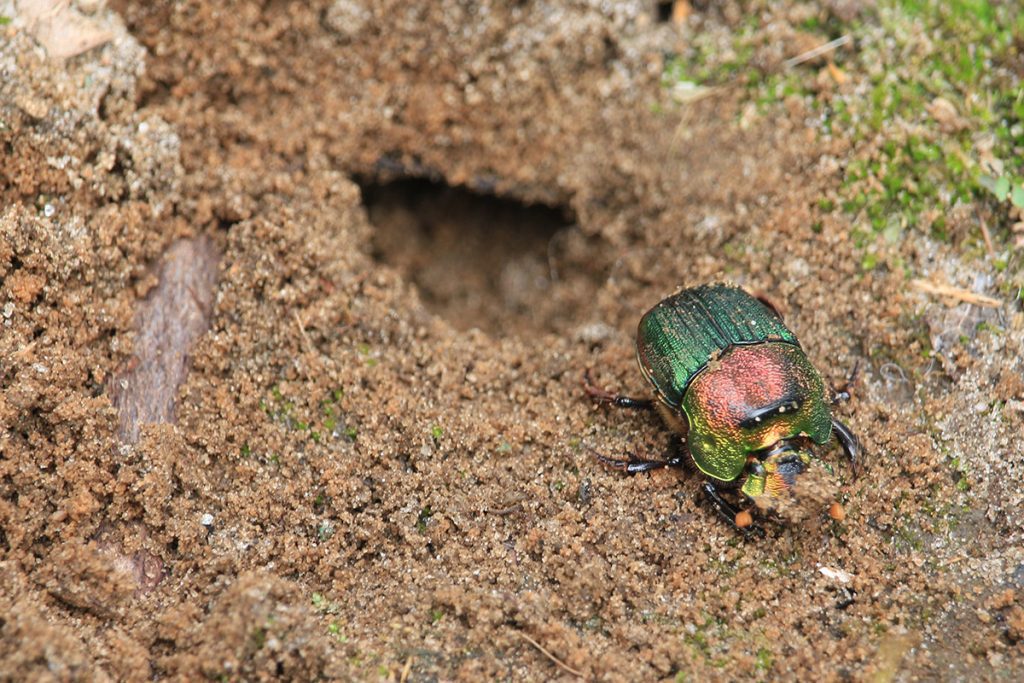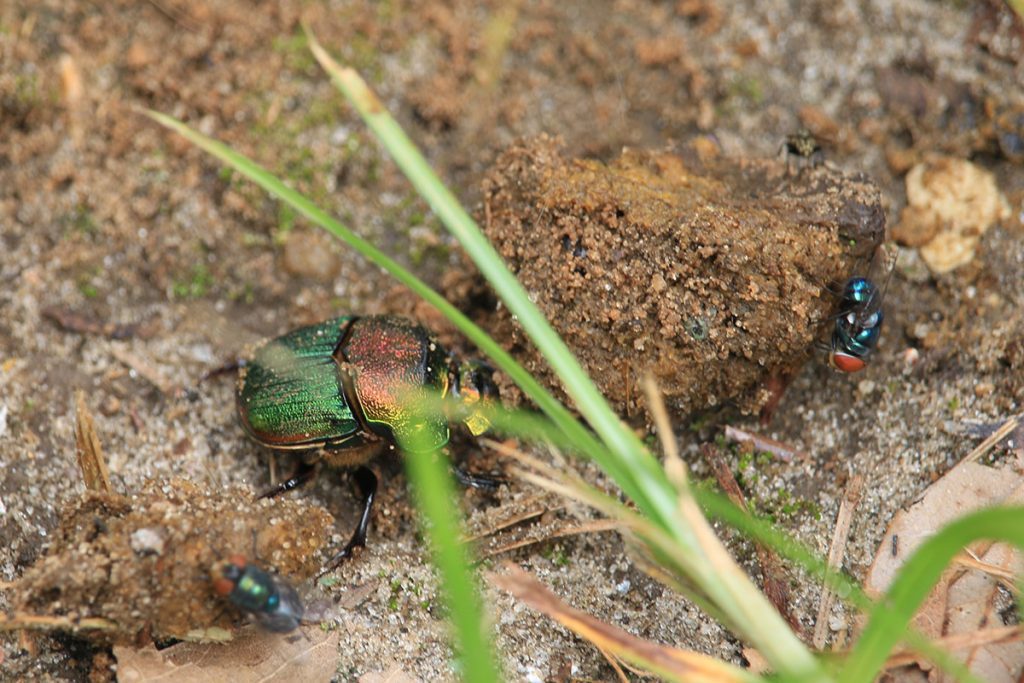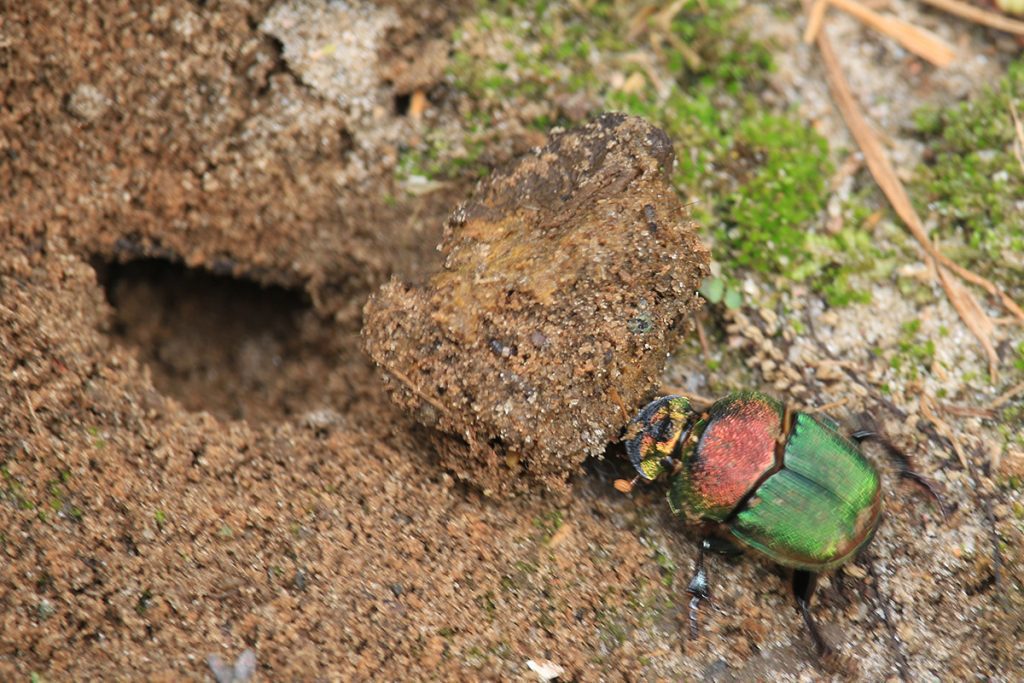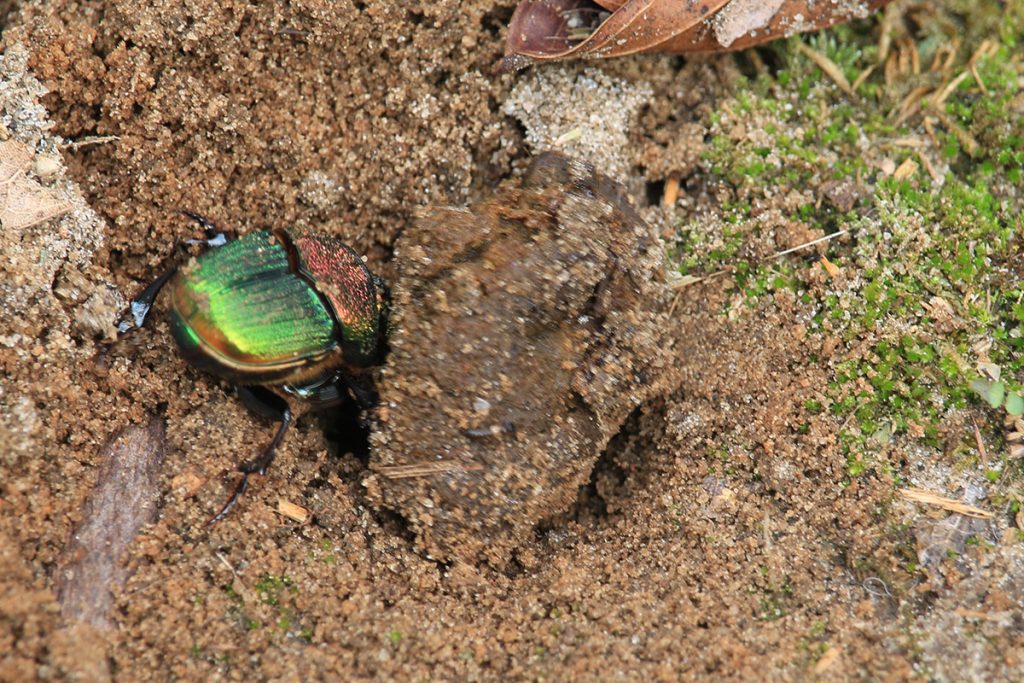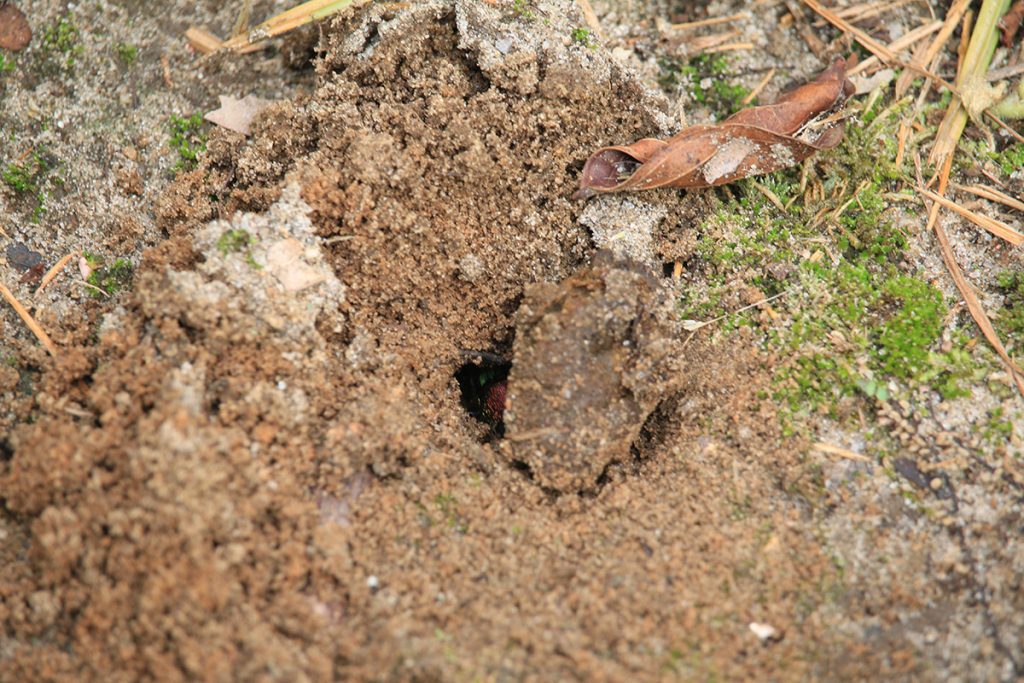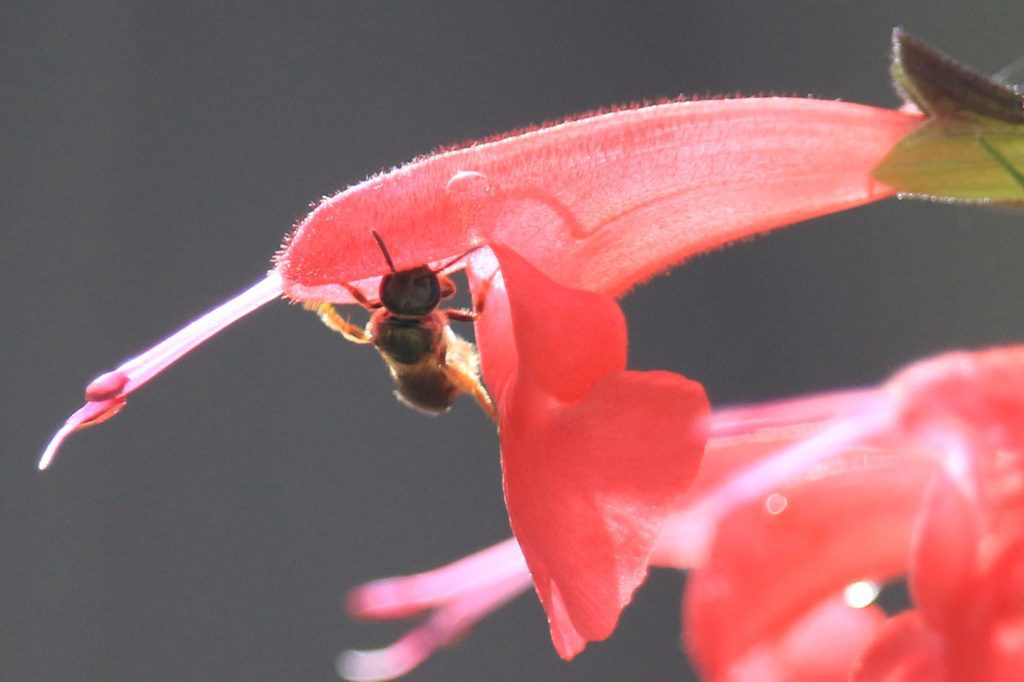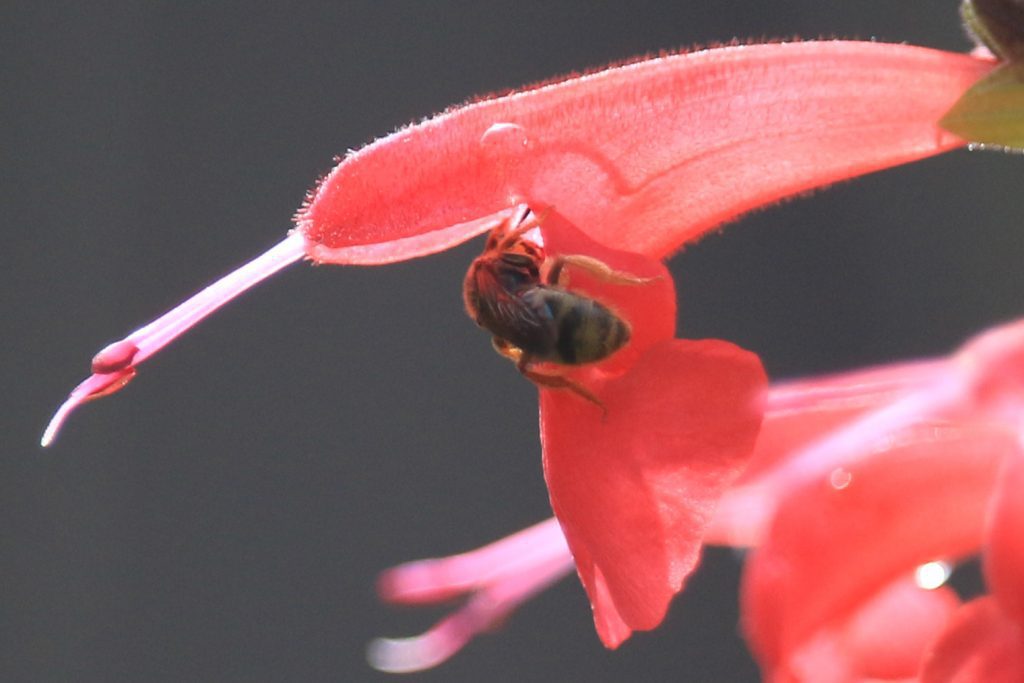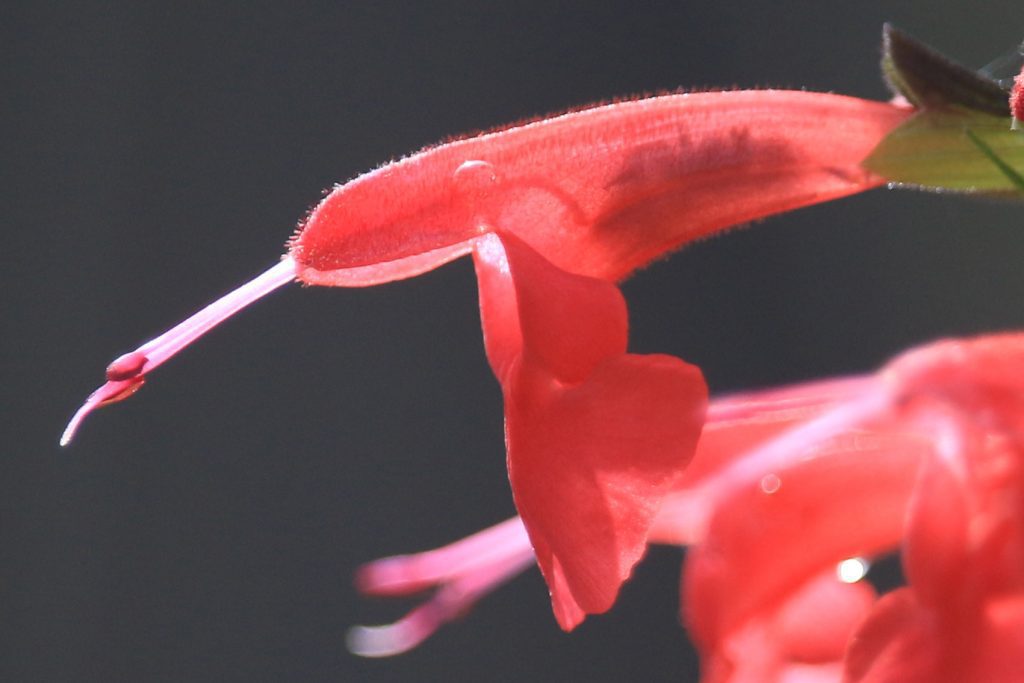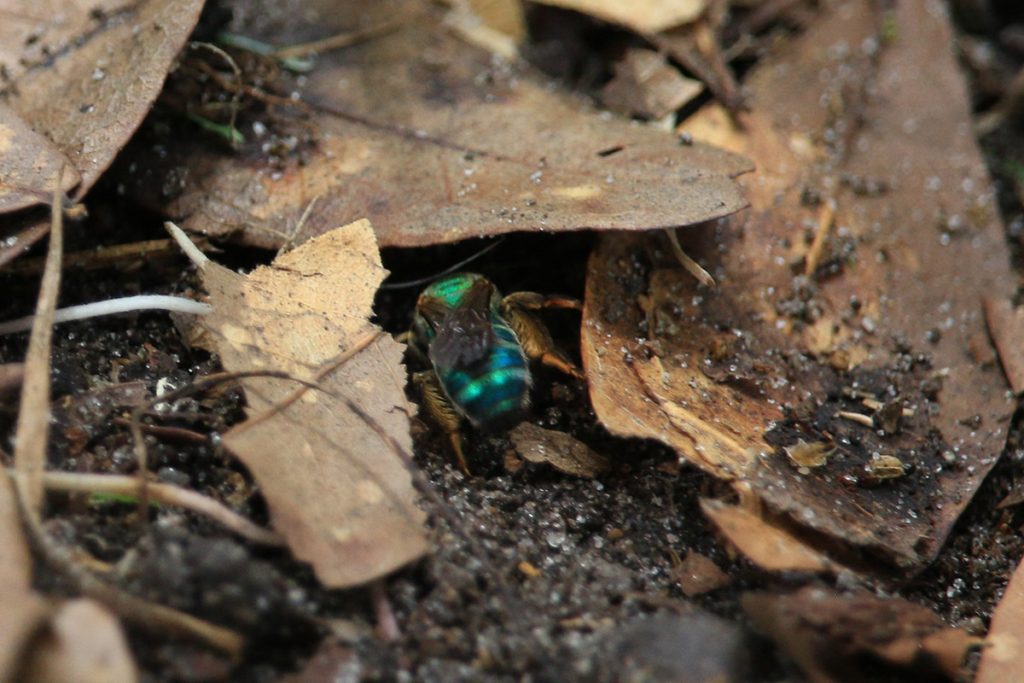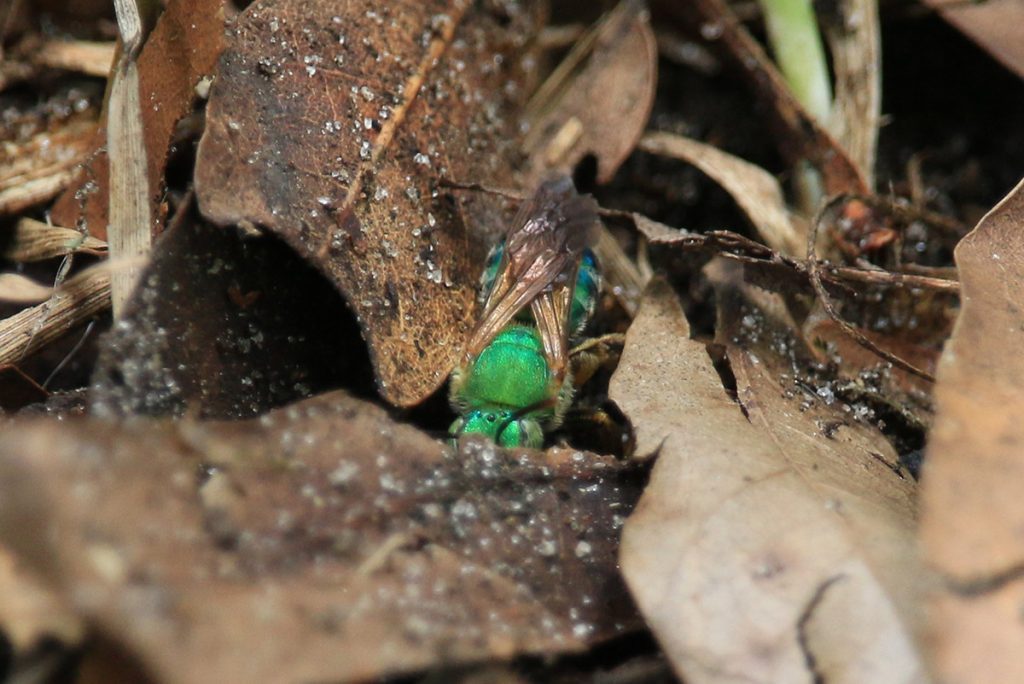I’ve been seeing headlines about it being the hottest July in recorded history. July in Florida isn’t the most pleasant time for outdoor activity. And yet, this is when the yard starts to get kind of magical. Life is just bursting here, if you can keep the plants watered and alive.
So what are we seeing? Pollinators? Yes! And quite a variety, too. Caterpillars? You bet! Baby birds? So cute!
Before all that, I want to start with a couple of kind of odd insects that fascinated me in July 2019:
Thieves and Nymphs
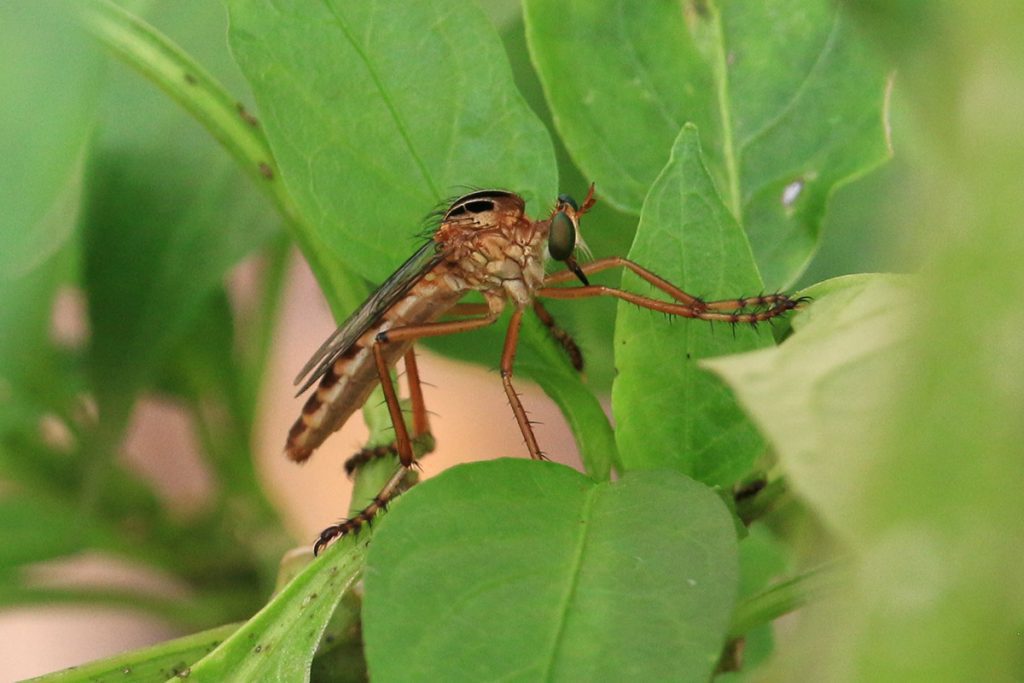
I caught this out of the corner of my eye, sneaking behind some leaves on our pepper plants. The closest thing I could get to an ID on iNaturalist was the genus Diogmites, or hanging thieves. Look at the spines on its legs, which it uses to help it grip plants and hang upside down. Hanging this way, this predator lies in wait for flying insects. Pretty cool!
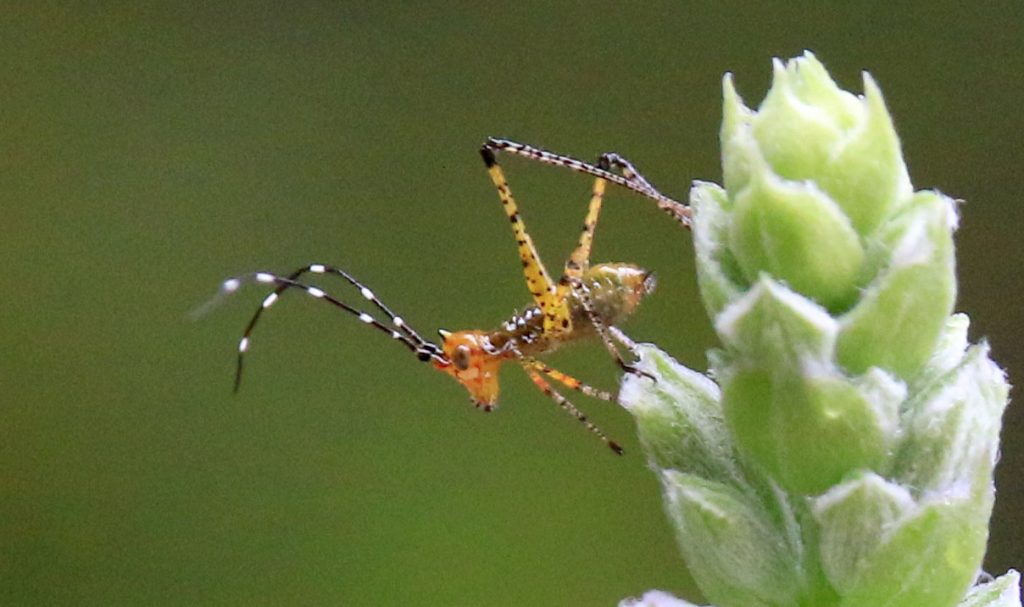
At first I thought the insect above was another predator- a ringed assassin bug. An iNaturalist user ID’d it as a giant katydid nymph. I googled katydid nymphs and, wow, that’s what they look like! And that makes sense, since I’ve seen (and always hear) adult katydids in the yard.
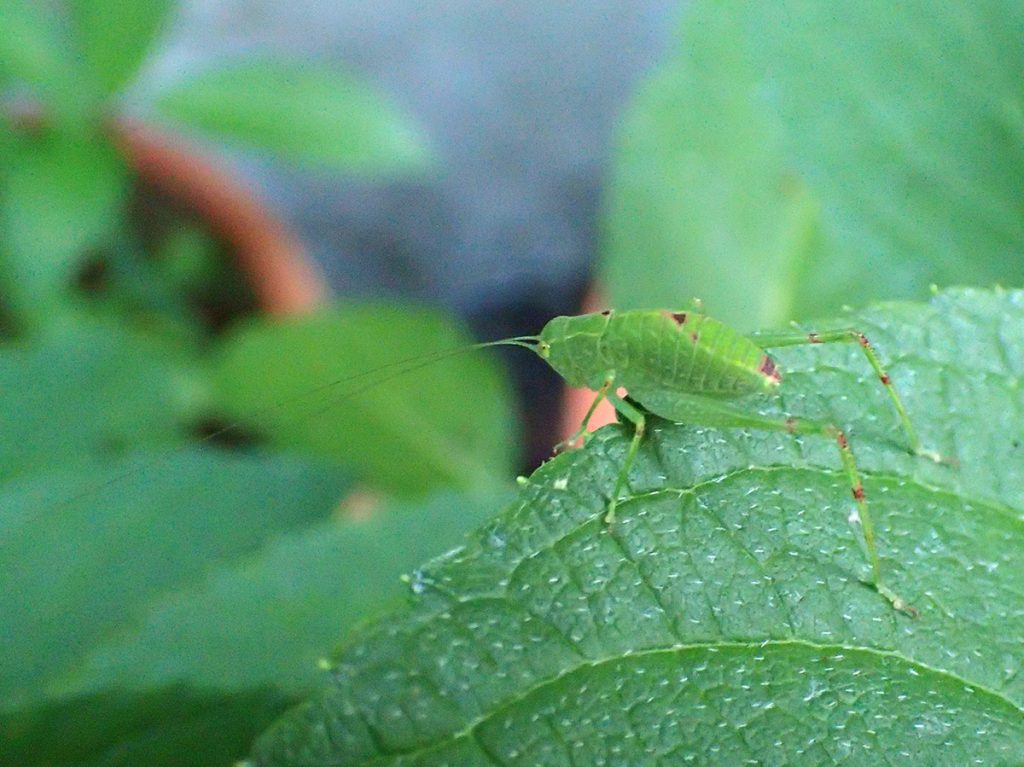
All right- who’s ready to see some pollinators! Okay, but first, kind of an unsung hero in the yard.
Let’s Watch a Dung Beetle Push Some Dog Poop Around
iNaturalist let me know that this dung beetle is specifically a rainbow scarab, Phanaeus vindex. If you disregard its job, this is kind of a cool looking animal. But that job- it’s not pretty. I found it kind of fascinating when I saw what it could do in the span of 30 minutes or so.
One morning when I was cleaning up dog poop, I noticed the ground throbbing just after I lifted a piece. So left the piece nearby and watched. At first, it looked like it was just covering its burrow, like a boulder at the mouth of a cave.
I went in and came back out about twenty minutes later. I found this:
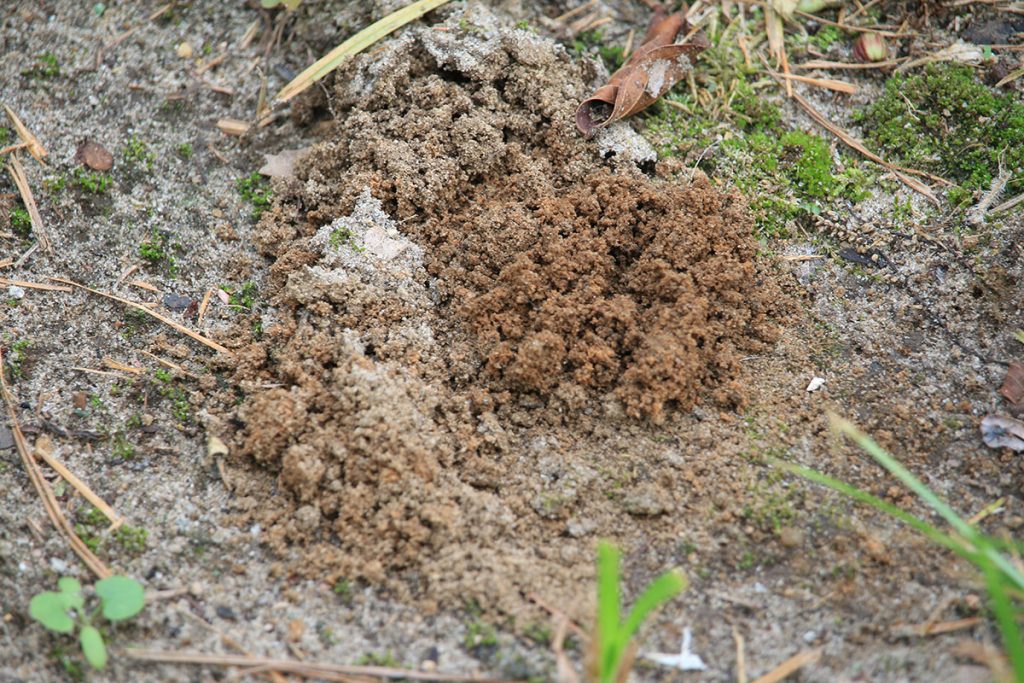
This is the patch in our yard where I lifted pavers, and I’m letting nature do its thing to reclaim the space. We’ll talk more about that later, the plants that have taken root here. But what I’m wondering is, are the spots where the dung beetles work maybe a little more fertile? Something to keep an eye on.
The other thing I found neat about this is seeing how the dung beetle works. It made that mound of dirt from beneath, where one would imagine its safe from a lot of animals.
So, sorry if that was gross. You know what’s not gross? Flowers! Butterflies! Bees! And let us not forget hoverflies…
Pollinators Part 1: Butterflies
This might have been our best month for butterflies in a couple of years. I credit that to a six by six foot patch where I planted native flowers. I’m also managing other plants (weeds) in my yard using iNaturalist to guide me. And some of these have favorable qualities for pollinators. Anyhow, I’m seeing a good diversity of bees and butterflies.
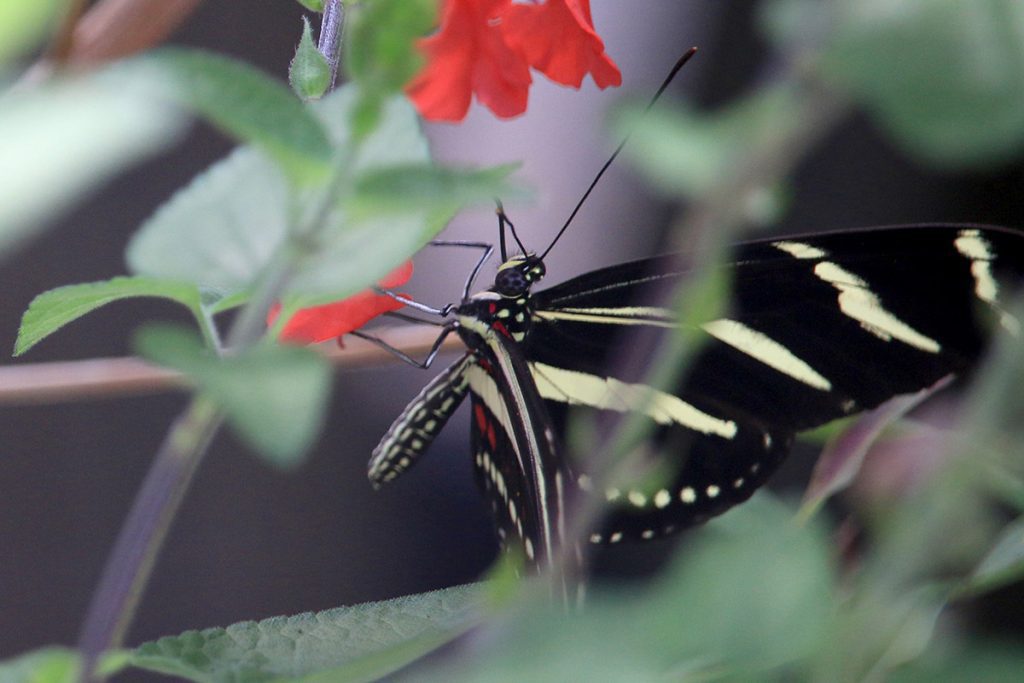
Last year, I didn’t see zebra longwings much in the yard besides one that would occasionally fly over. And I saw that there were fewer counted in Leon County during NABA’s summer butterfly count. Their numbers were possibly affected by a cold winter in 2o18. This is a tropical butterfly, and we’re at the north of its range, so it stands to reason that it would be more affected by cold than other species. Happily, this one was a regular in the yard for a few days.
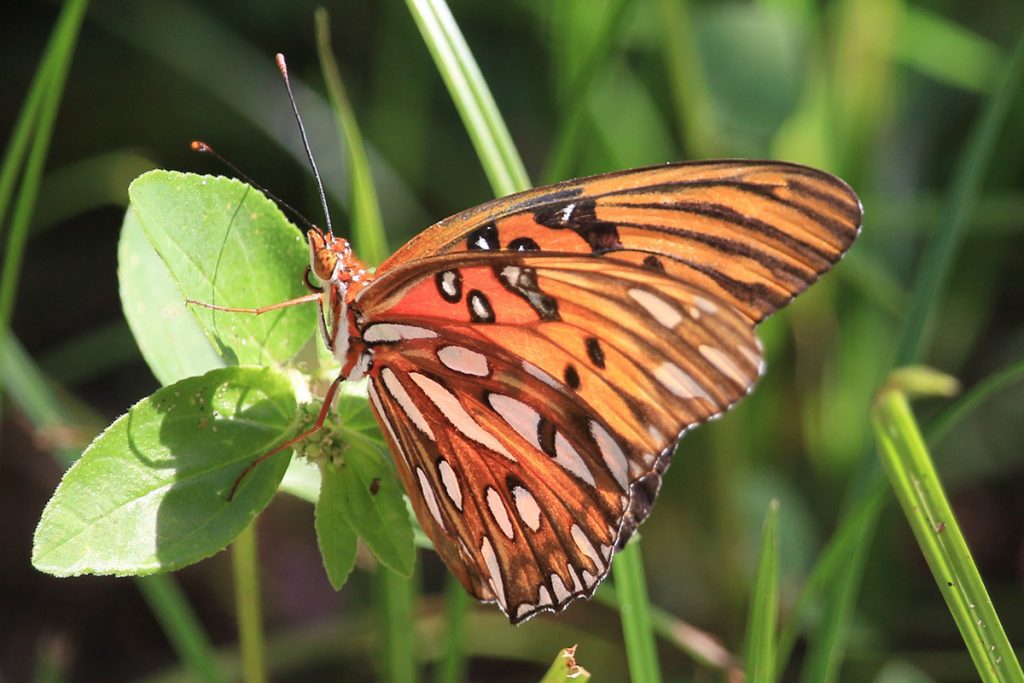
I don’t want to be unappreciative of the skippers and duskywings we’ve had in the yard until now. I think they’re cool. But I love seeing the big, colorful butterflies as well, like this gulf fritillary. July had a good mix of butterflies.
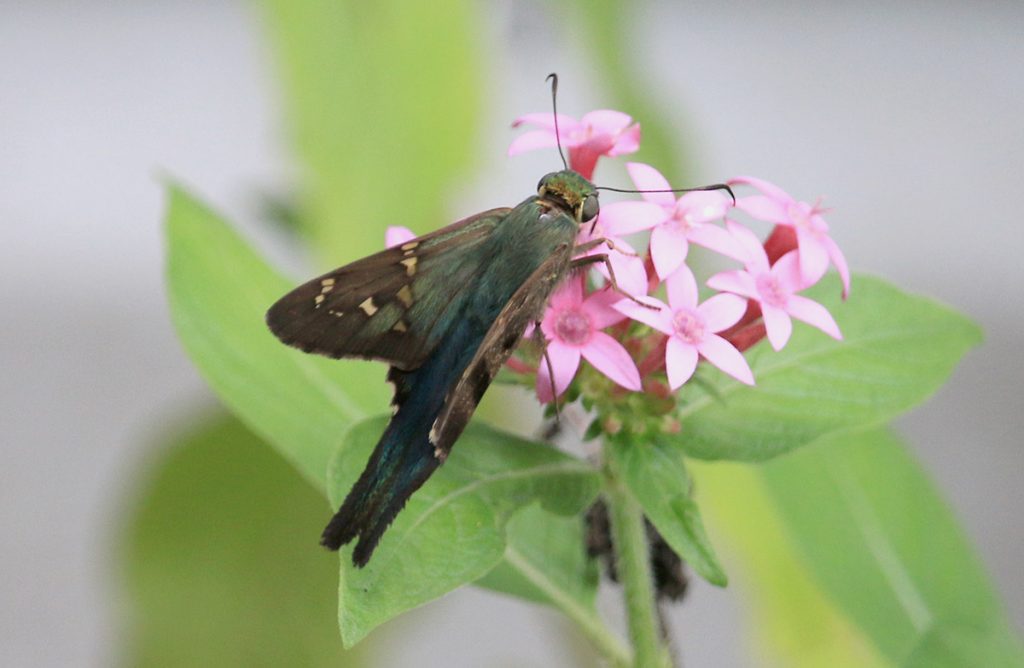
Here’s my favorite of the skippers, the long-tailed skipper. They’re the one constant of the garden from year to year, likely because I always plant their larval food- beans and peas. We have three other butterflies that lay eggs in the yard annually, but those monarchs and swallowtails don’t often stick around to pollinate flowers. We had all four species in the yard in July, so we’ll do a separate caterpillar section below.
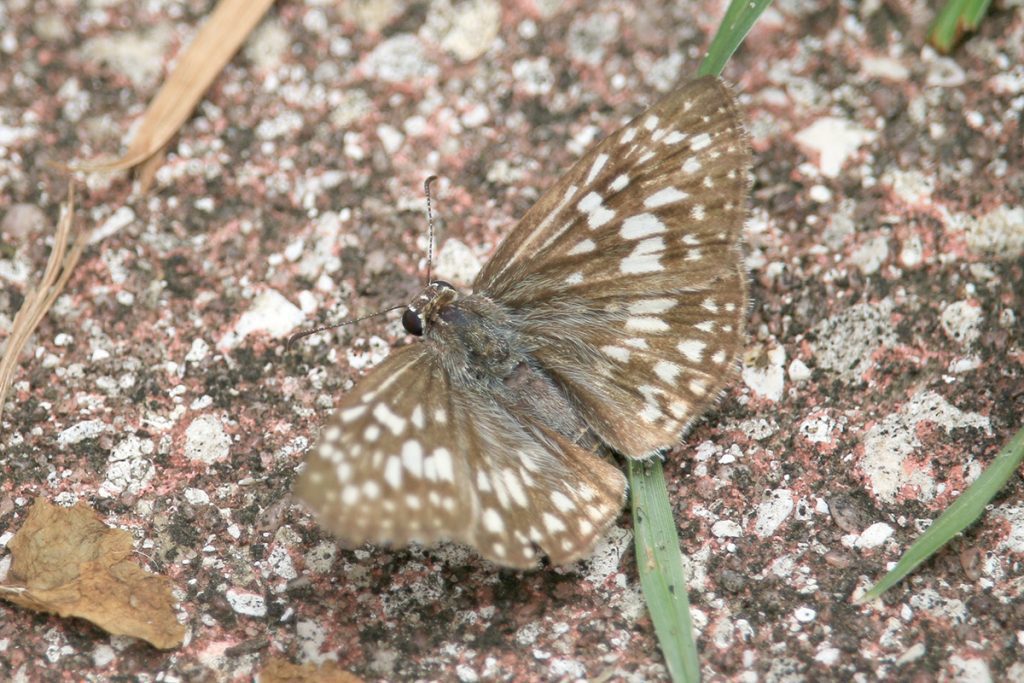
My butterfly guide doesn’t list a common checkered-skipper, but I’ve been seeing the ID pop up in iNaturalist. Evidently, the only way to tell the two species apart is with a microscope, or by dissecting them. Doing some further research, it seems more likely that it’s a white checkered-skipper, just based on range maps. We are close to the southern part of the communis range, though, and we can’t easily tell them apart…
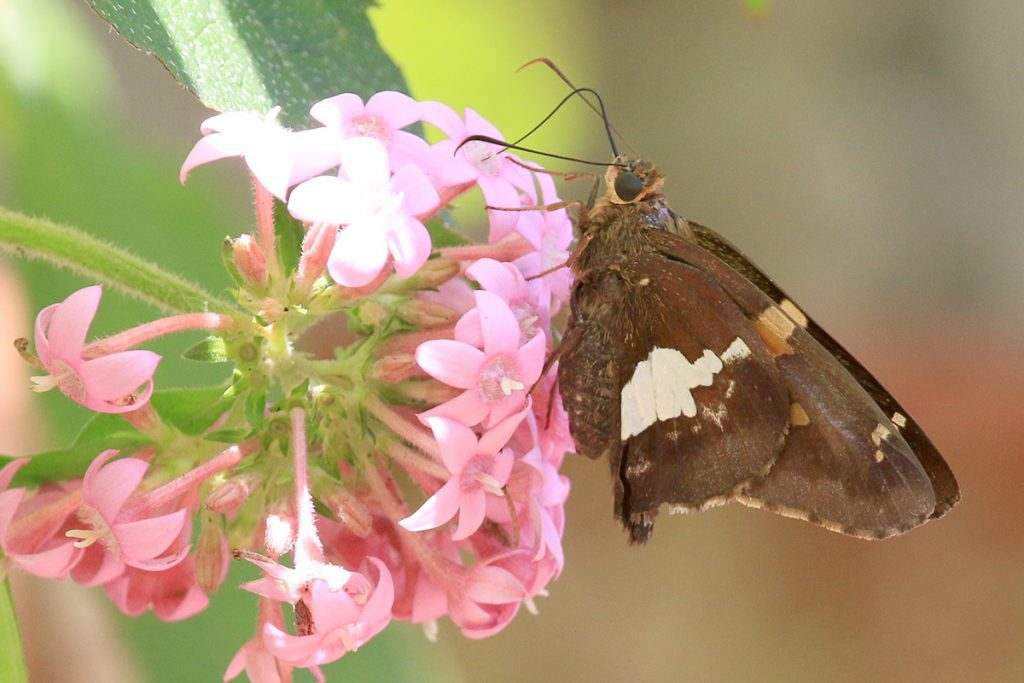
Here’s another pretty skipper.
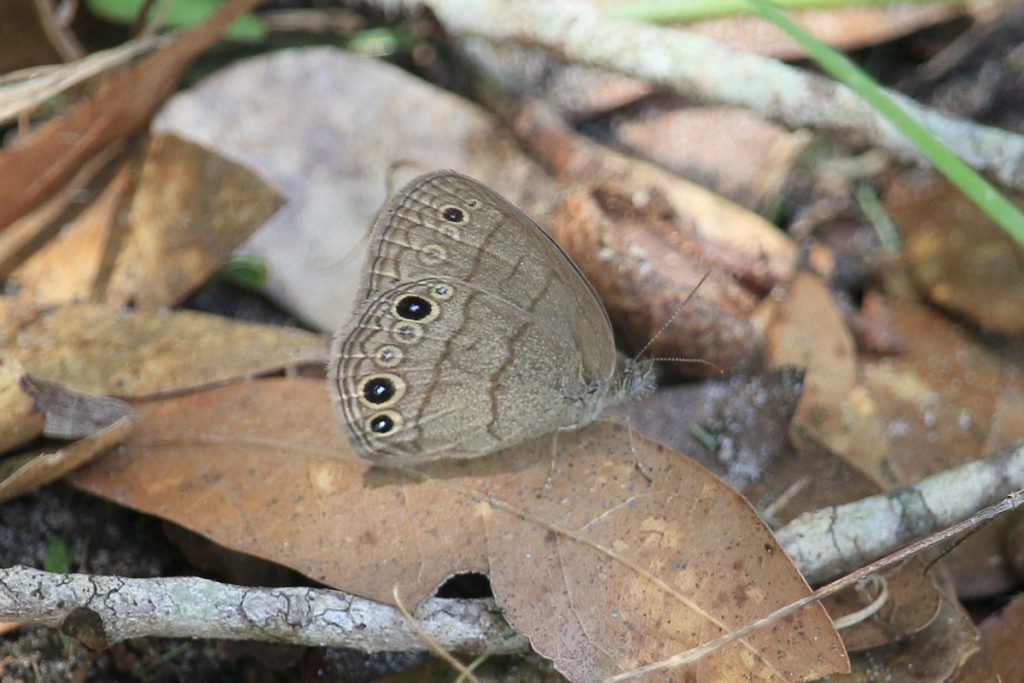
I find these in our front yard, under the shade of three trees. They’ve very small and inconspicuous, often resting in the leaf litter.
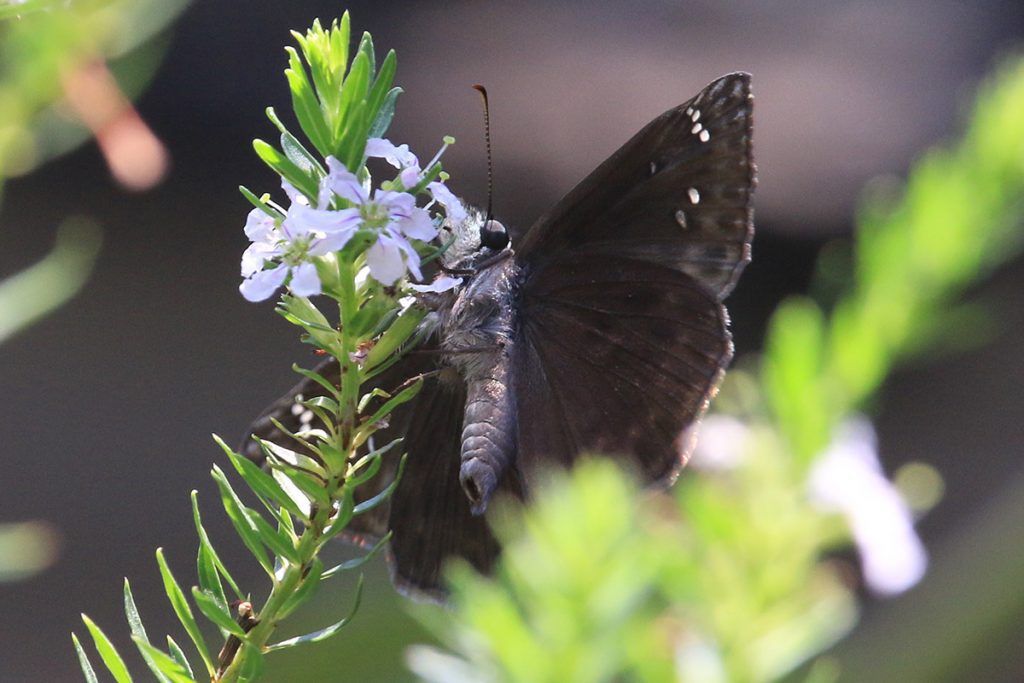
And here’s a look at a Horace’s duskywing, a species that’s been pollinating here for the last few months.
Pollinators Part 2: Native Bees
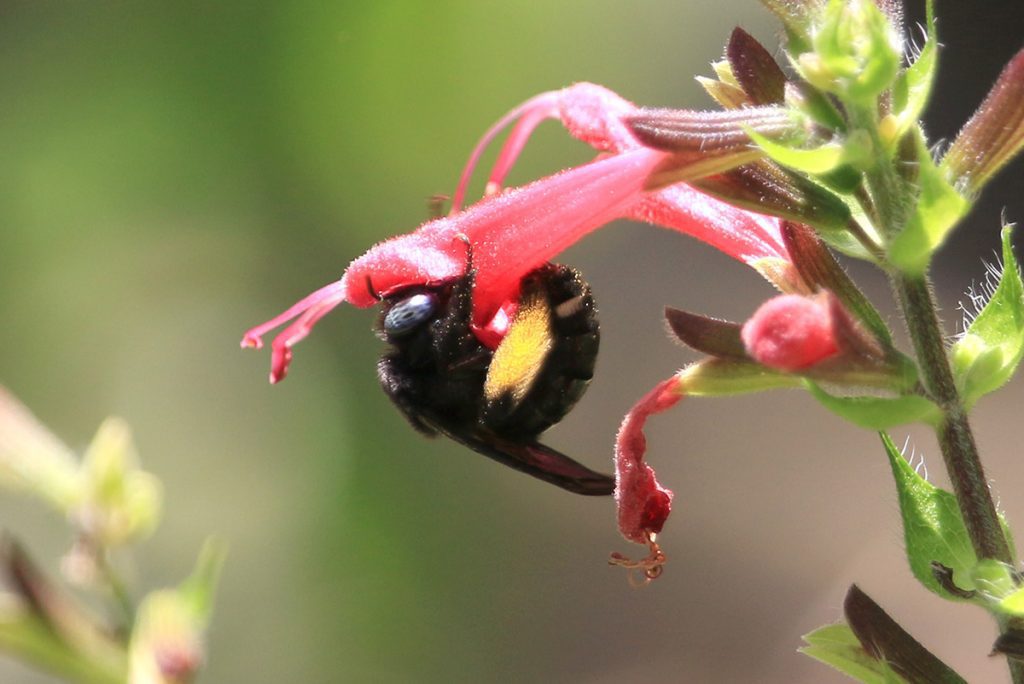
In July I started noticing new bee species pollinating our flowers. They can be tough to photograph, but it’s worth it when I can see the diversity of native species we have.
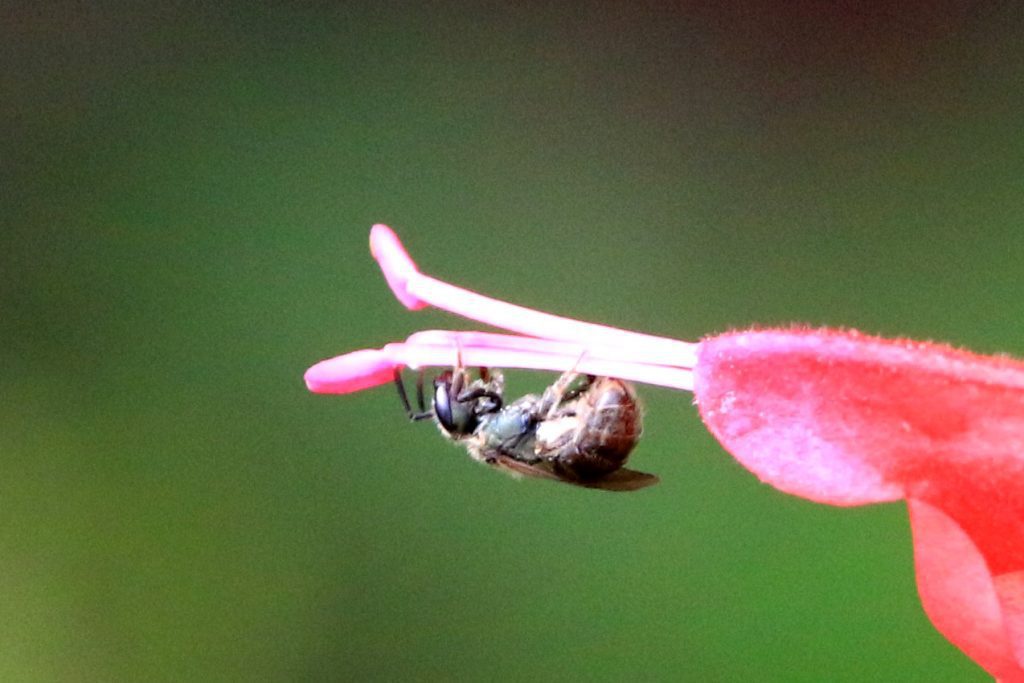
iNaturalist users ID’d this one as a type of metallic sweat bee. This is a small bee- if I didn’t zoom in, I might have thought it was a fly. Take a look at how this bee pollinates the red salvia flower (and compare the size with the long-horned bee above, on the same flower):
I’m not getting specific IDs for some of these bees, and part of that might be how hard it is for me to photograph them (practice, practice, practice). The salvia and wing-strife plants have a series of small flowers, and bees will quickly move from one to another. In May, when I photographed a Poey’s-Furrow bee, it was on a nice big purple coneflower- plenty of pollen in one place. And a much easier photo to take.
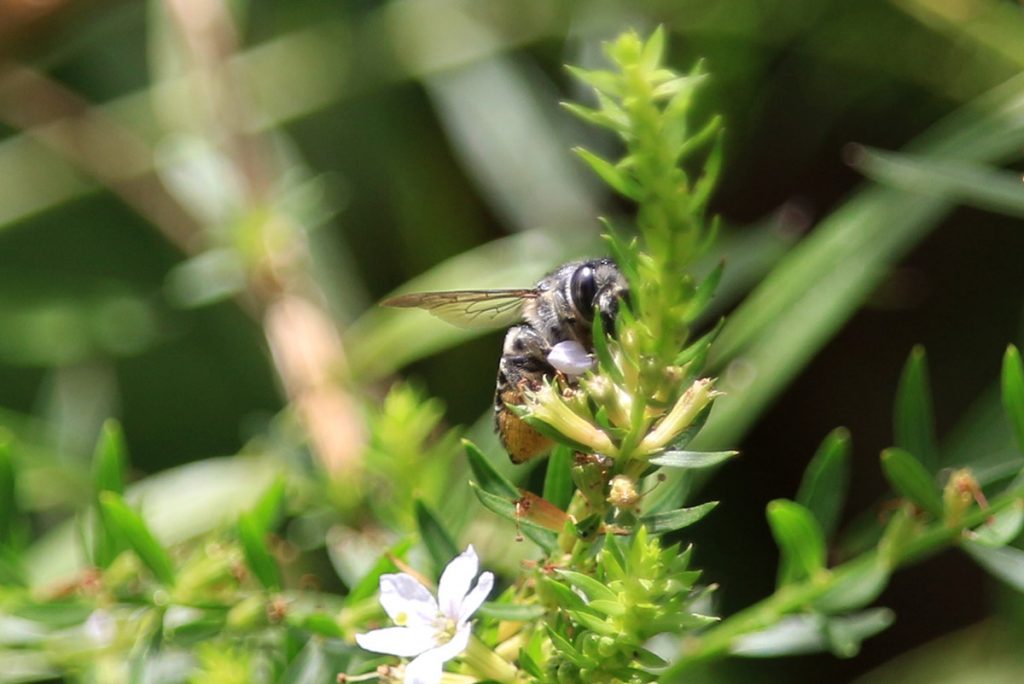
Again, not a very specific ID.
I tore out some old wooden benches from the backyard, and saw two pure green metallic sweat bees fly out. These are my favorite bees. I didn’t get a great photo of them, but I did see them apparently looking for a new home. From what I read, they will make their nests in rotting wood, or on bare ground. Here we see one starting to dig.
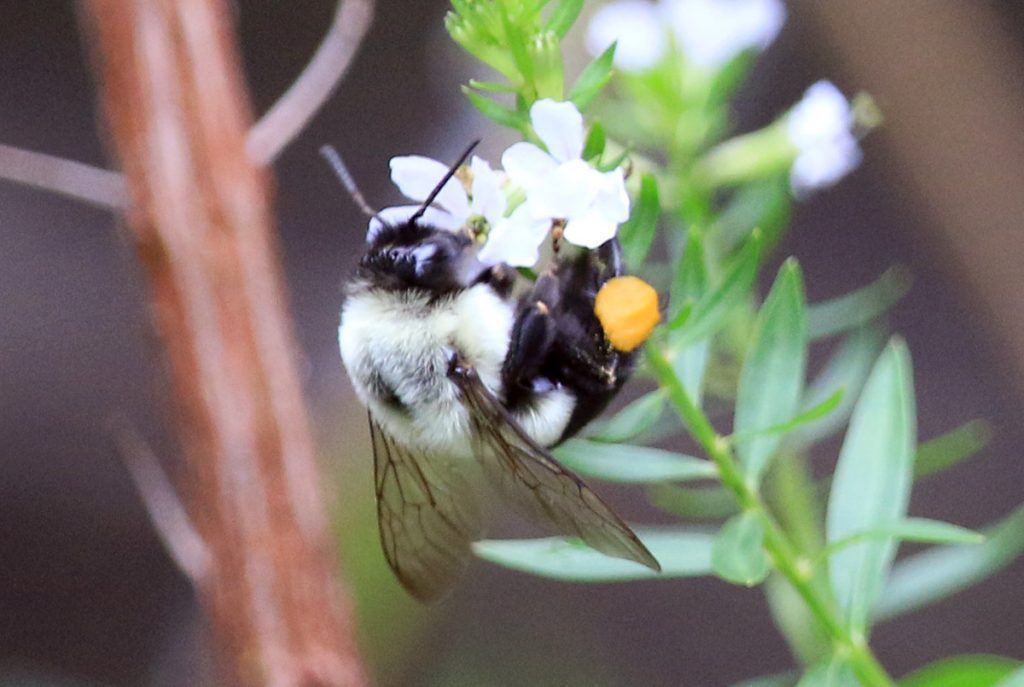
Towards the end of the month, I started seeing bumblebees and blue metallic sweat bees in the flower bed. These are the bees I have always seen in the yard, but until recently, I’d been seeing other species.
The more closely I pay attention, the more diversity of native bees I notice. Counting the Poey’s furrow-bee and the carpenter bee I photographed in May, I’ve photographed seven native bee species in our yard this year. A lot of the credit has to go to the amount of pollen we’ve added to our yard. But these are ground nesting bees, and I also exposed more of the ground by removing pavers. Our yard is feeling more like a habitat this year.
Pollinators Part 3: Wasps
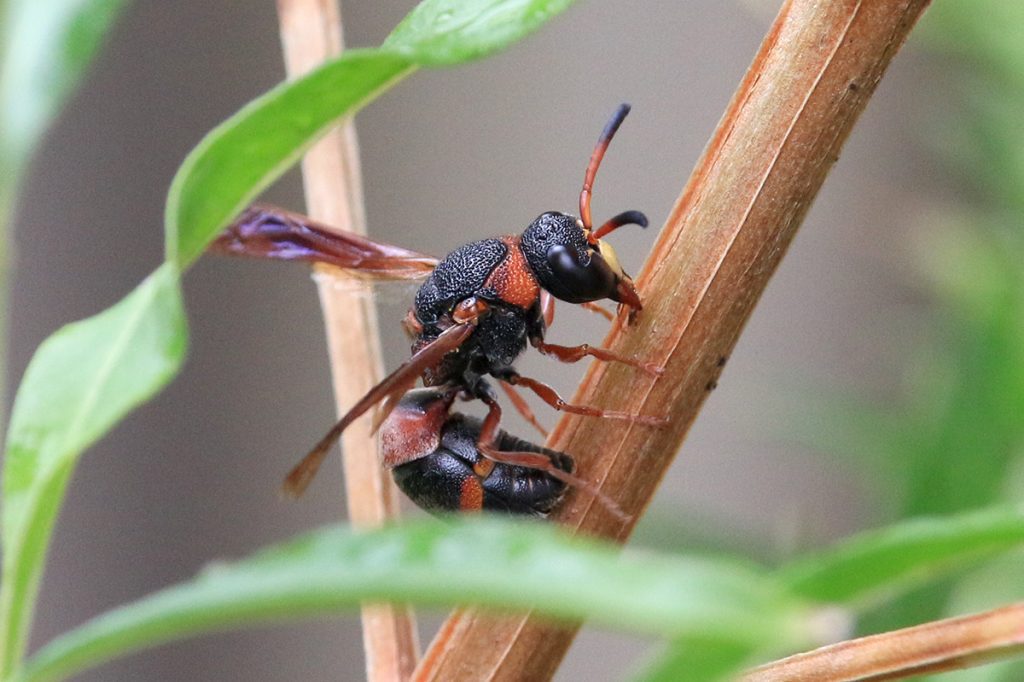
At certain times of day, there is quite a lot buzzing around these flowers. And it’s not just those native bees that us environmentally minded folks get excited about. The mason wasp above is a regular pollinator on our plants.
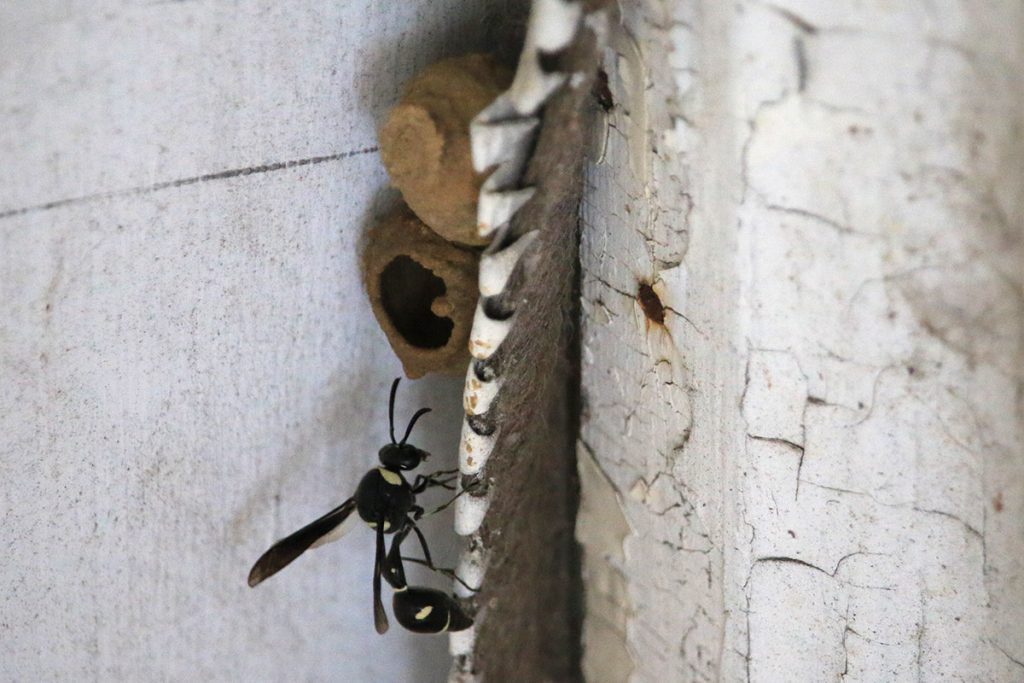
Maybe you’ve seen these little clay pots against your home? These are the nests of fraternal potter wasps. If you watch these structures (instead of say, hosing them off the side of your house), you may see a potter wasp fly in with a small caterpillar. This is a little meal for its larvae.
I’ve been noticing wasps grabbing caterpillars in the yard. But then I also see the same wasp species pollinating flowers. That got me thinking about their feeding habits. I read the little tidbit about potter wasps feeding insects to their young after clicking on the wasp’s name on iNaturalist (there’s an about section in there, which I recommend clicking and reading to learn more about the flora and fauna in your yard). Googling wasps, I learned that the behavior is consistent among most solitary wasps. Adults feed themselves nectar, but forage for insects to feed their larvae.
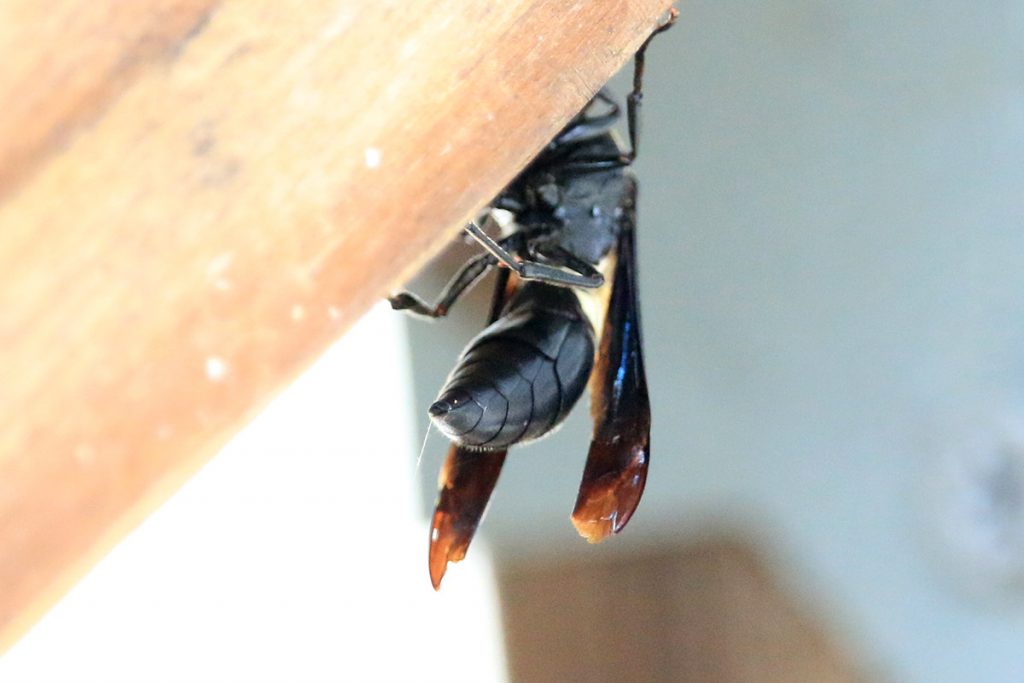
If you look back to the 2018 Backyard Ecology Blog, there’s a photo of a four-toothed mason wasp bringing a caterpillar back into its cavity on the underside of a wooden railing. But this wasp has a relationship with another insect that I’ve been observing:
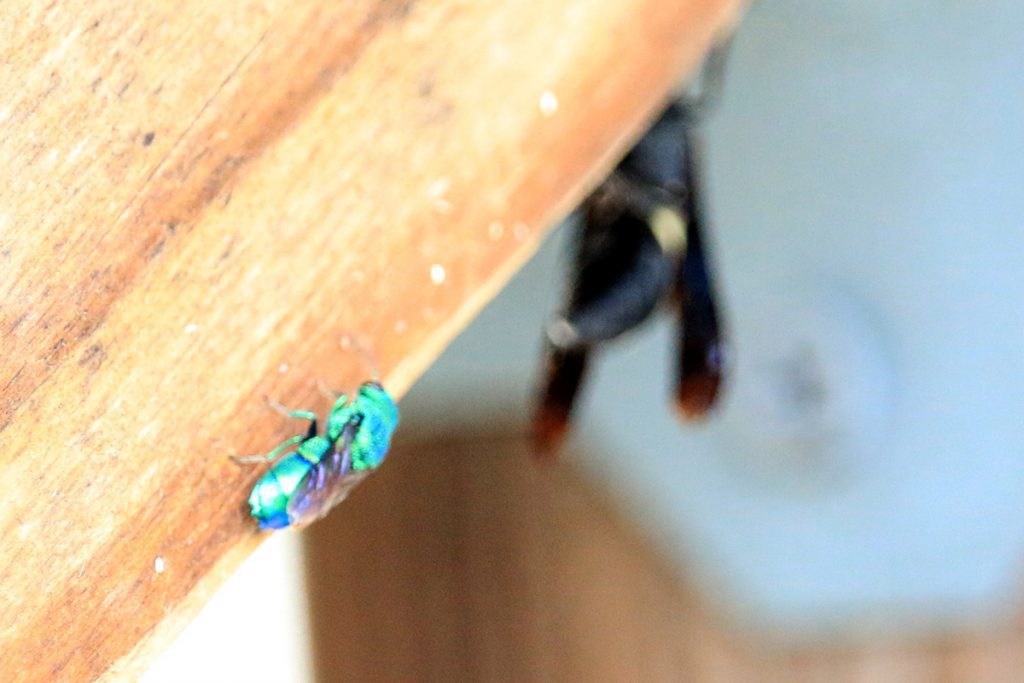
I apologize for the quality of the photo. The blue wasp is a cuckoo wasp, which lays its eggs among wasps of other species. I’ve seen the cuckoo wasp enter the mason wasp’s cavity before. But this is the only time I’ve seen the cuckoo wasp waiting for the mason wasp to leave.
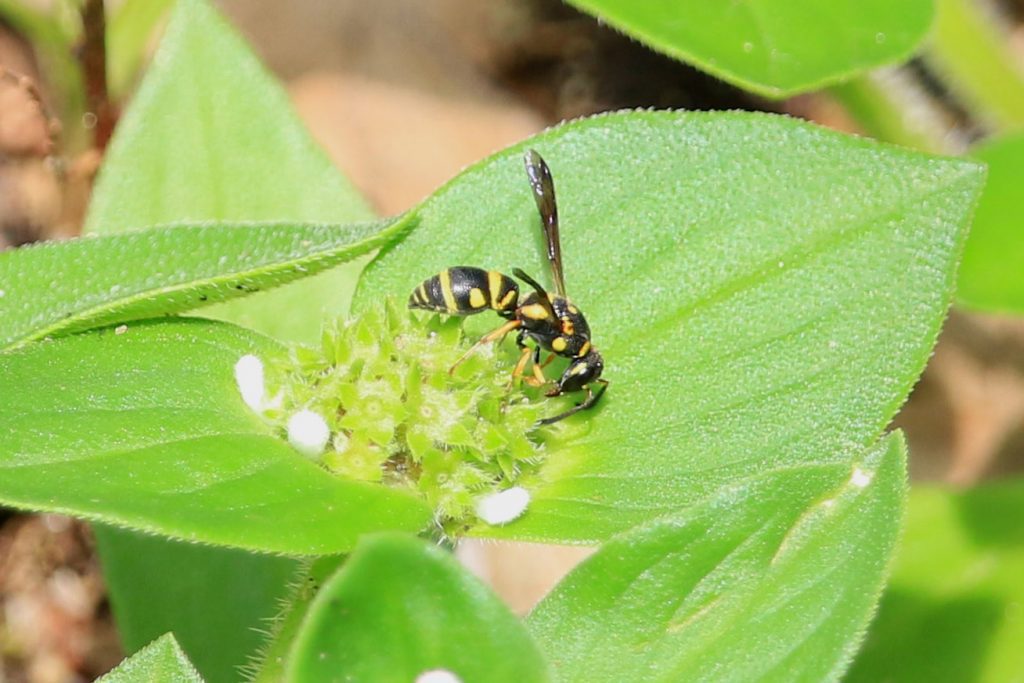
I thought his might be a yellow jacket, but iNaturalist identifies it as a mason or potter wasp. That makes sense- yellow jackets are social wasps, and this is a solitary wasp. The flower its pollinating is considered a weed by many- Florida pusley. But it is native, and it does provide nectar. On a Sarasota IFAS blog post on the plant, you can see discussion in the comments section about how it takes over lawns. One person even complains that there are too many bees!
There are a lot of ways to manage your lawn, and we all have different goals. I’m not a field of grass kind of guy, so I like seeing a diversity of plants. And I want that diversity of plants to host a diversity of wildlife. Which brings us to…
Pollinators Part 4: Hover flies
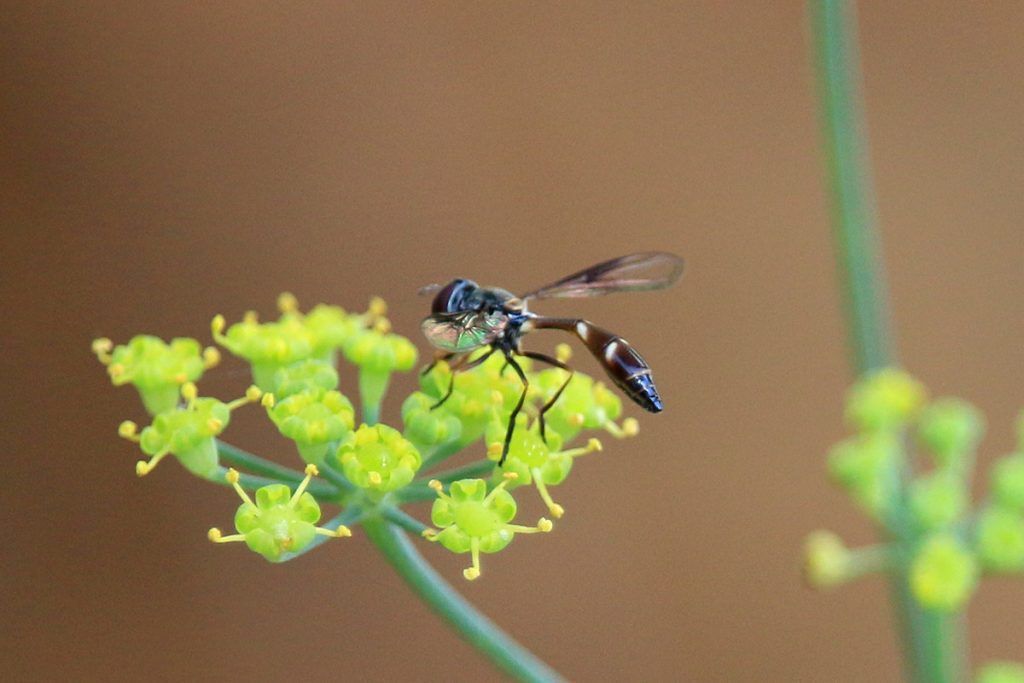
This is the third hover fly- or syrphid- species that I’ve identified in the yard this year (I saw one in March and one in February). These are fascinating little insects. They are bee mimics, though I’d call the four-speckeled hover fly a wasp mimic. They are pollinators, and as we’ve seen time and again on the Backyard Blog, their larvae eat aphids (two species of larvae that I’ve seen, one in March and another in June). This is a doubly beneficial insect.
Pollinators Part 5: Moths
Everyone’s favorite pollinators! Not really. To most people, butterflies and bees are the face of pollination. And don’t we love hummingbirds? Most don’t know what a hover fly is, but they have likable traits. Then there are wasps and moths.
There are a lot of cool, weird looking moth species. But most are small and brown, and are mostly indistinguishable from one another unless you take a close look and bother to learn about the different species.
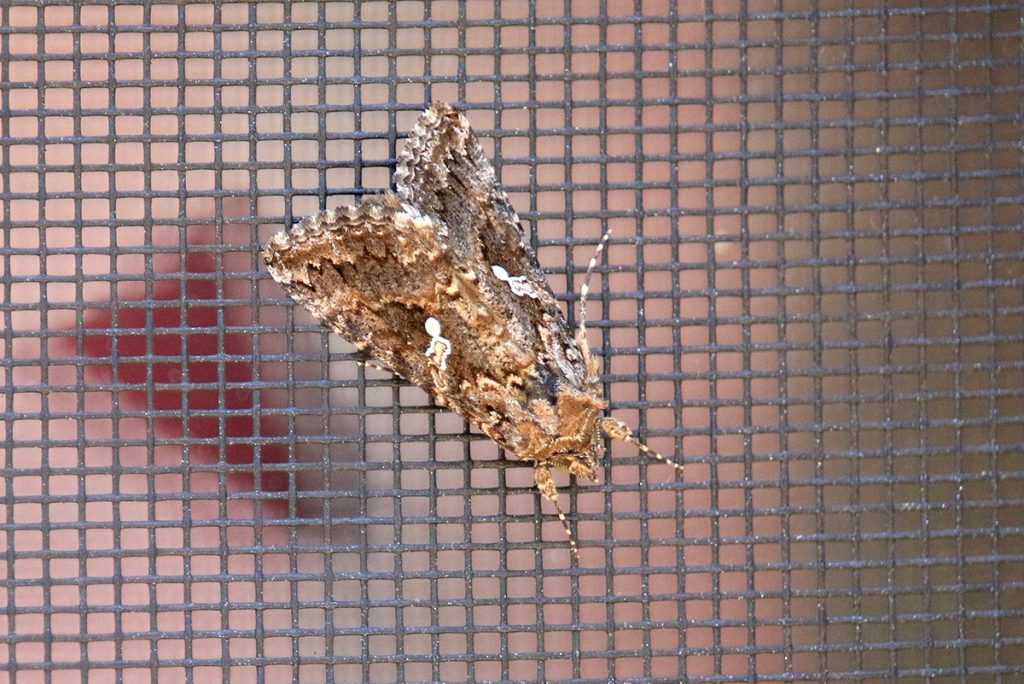
And then, aside from the fact that not everyone finds them attractive, and that they’re nocturnal, there is a legitimate reason people find moths distasteful. It’s their larvae. I haven’t gotten confirmation, but my initial iNaturalist ID for this moth is that it’s a cabbage looper. Their caterpillars, one of which you can see in the 2018 Backyard Blog, are garden pests. Many moth caterpillars are.
So how are they different than butterfly caterpillars? They do the same thing- decimate their host plants. But I plant milkweed and fennel with one purpose- to host specific butterflies. I plant tomatoes to feed myself. The long-tailed skipper I love has caterpillars that nibble on my bean plants. I don’t mind the damage, and I still harvest beans. But, if you lose all of the dill that planted for yourself, you may not love black swallowtail caterpillars.
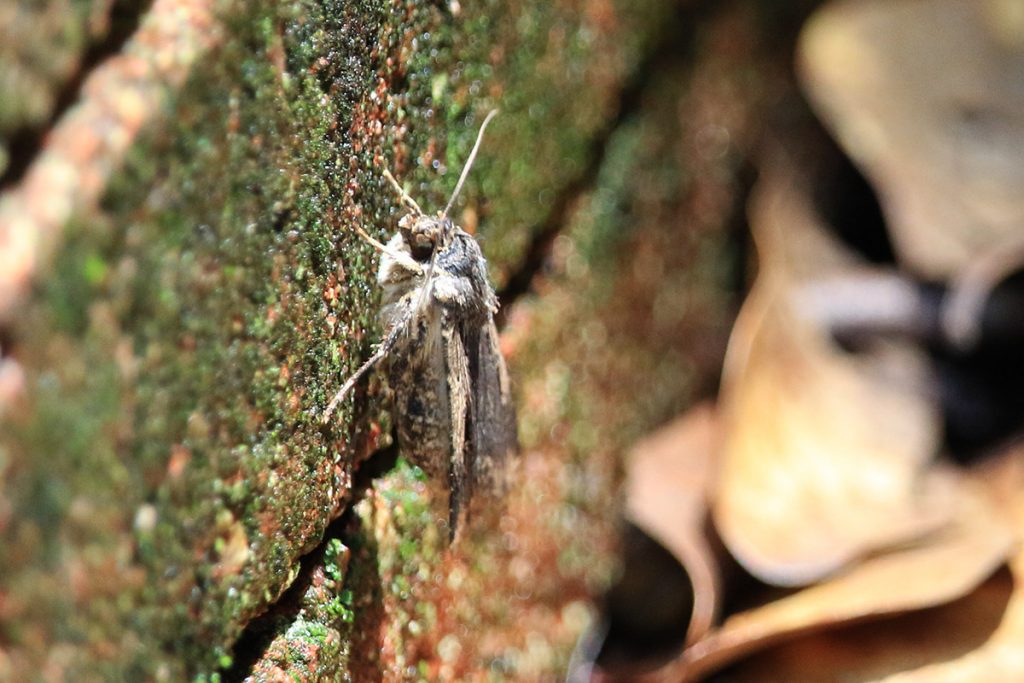
Again, I don’t have confirmation, but this is possibly a cutworm moth. You’ll notice this and the previous moth are named after their caterpillars, which are both garden pests. And cutworms are common in our yard. Cutworms are kind of a pain because, unlike other butterflies and moths, these are generalists. Monarchs eat milkweed, giant swallowtails eat citrus. They’re specialists. But I find cutworms on everything.
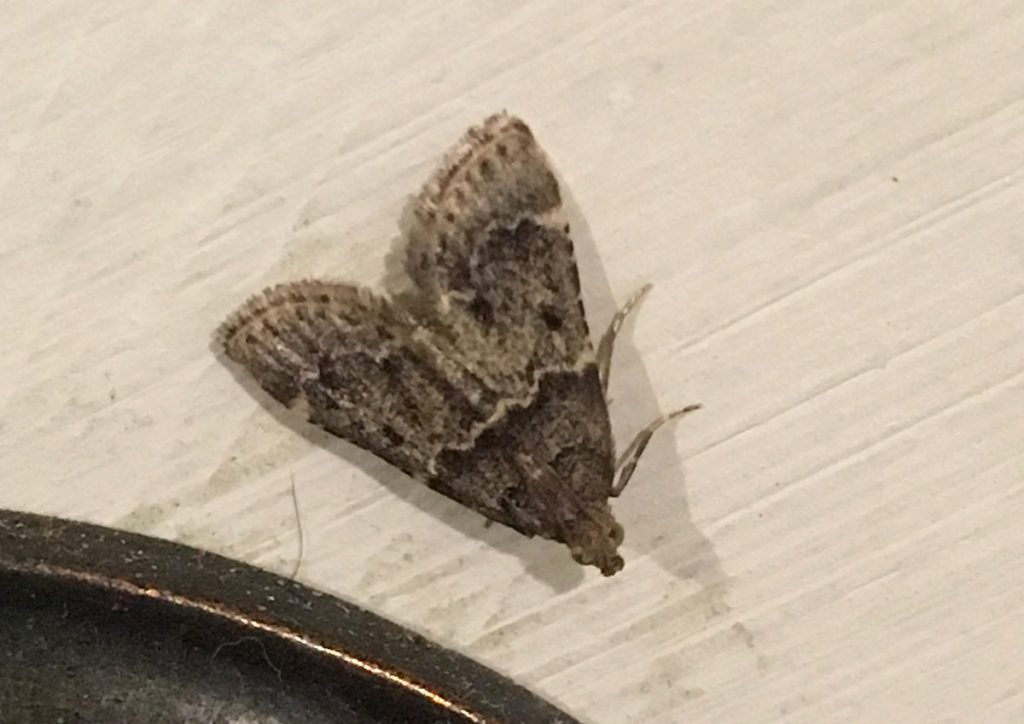
And lastly, this one got into our house. Note the name, again referring to a caterpillar. Webworms are found in colonies, often high in trees, enclosed by a web. I’ve seen the webs high up in our pecan tree. They’re mostly harmless in the vastness of leaves high up in that tree.
Moths are pollinators, but as you see, we already have plenty of pollinators. So, why not squash all these “pest moths” before they lay eggs on my plants? What value do they really have?
We need the bottom end of our food web
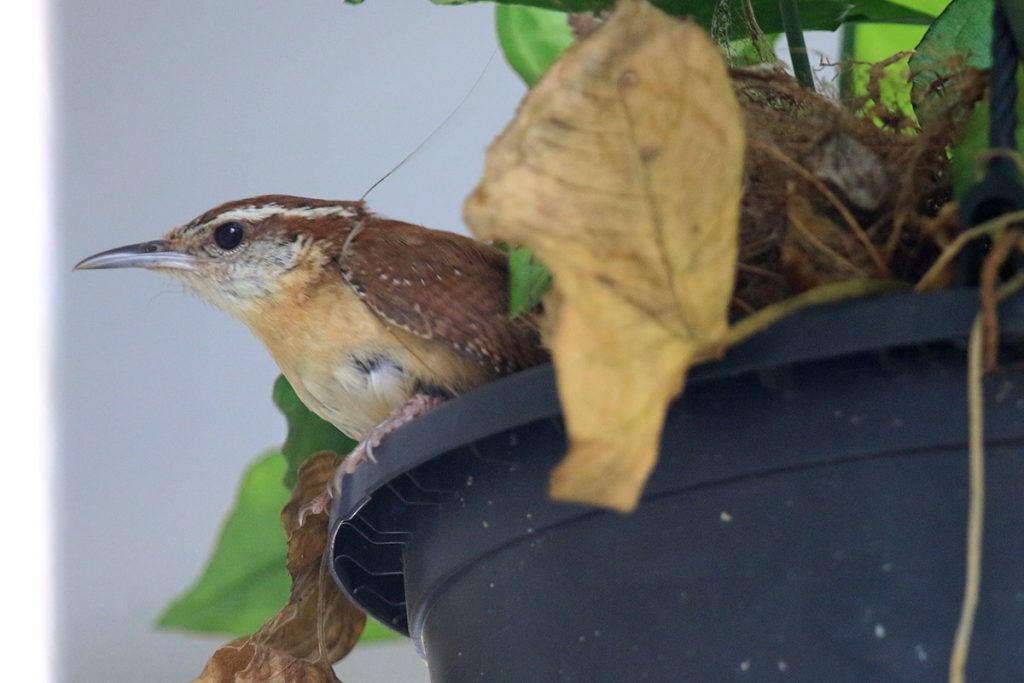
Every morning in early July, when I watered this one hanging plant, a wren would fly out. One morning I turned the plant around and found a nest.
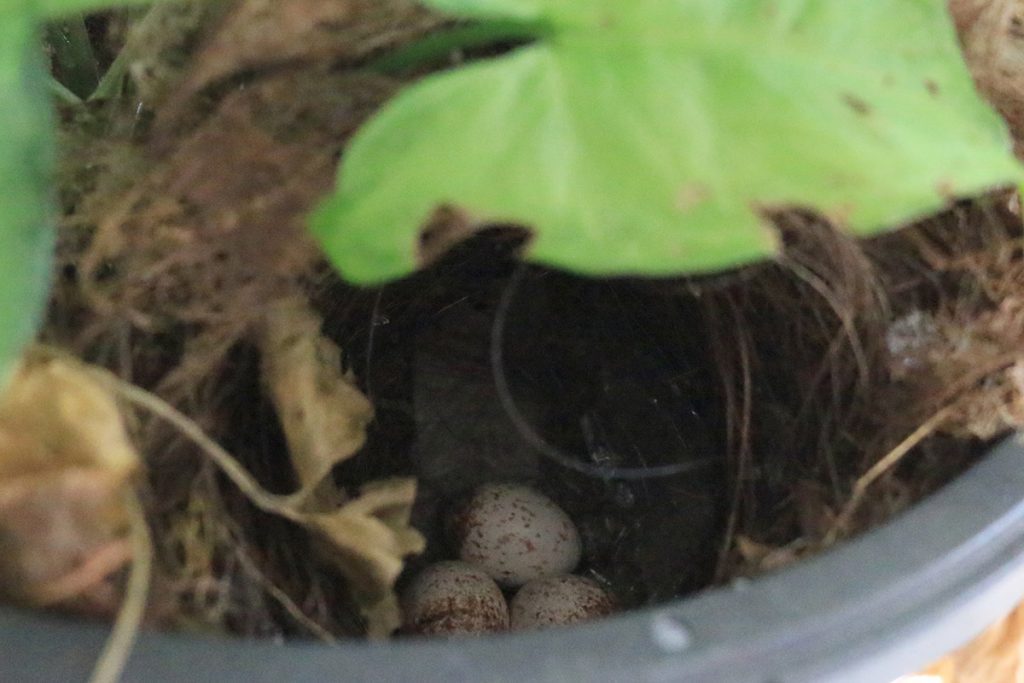
One day when I watered the plant, the wren didn’t fly out. So again, I took a quick peek:
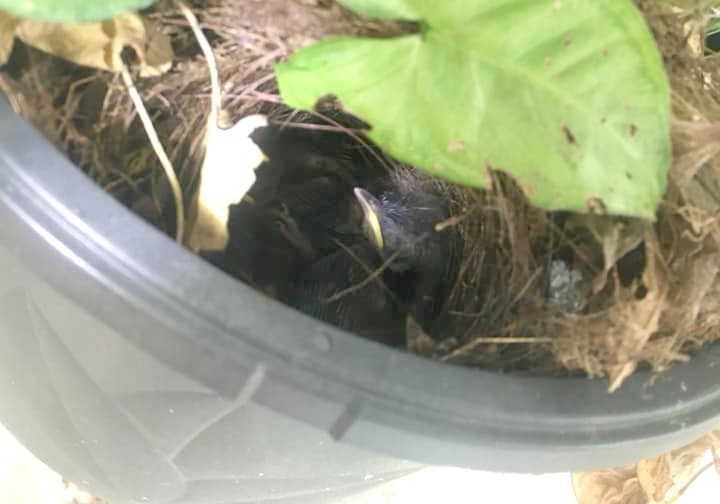
Then I heard the call of the parent, and turned to see it with a caterpillar in its beak. So I moved out of the way to let it feed its three chicks.
Wrens have been foraging all over the yard. I’ve seen them picking at vines I should have weeded out. We also have young cardinals foraging. They especially seem to like the flower bed where we’ve seen so many pollinators.
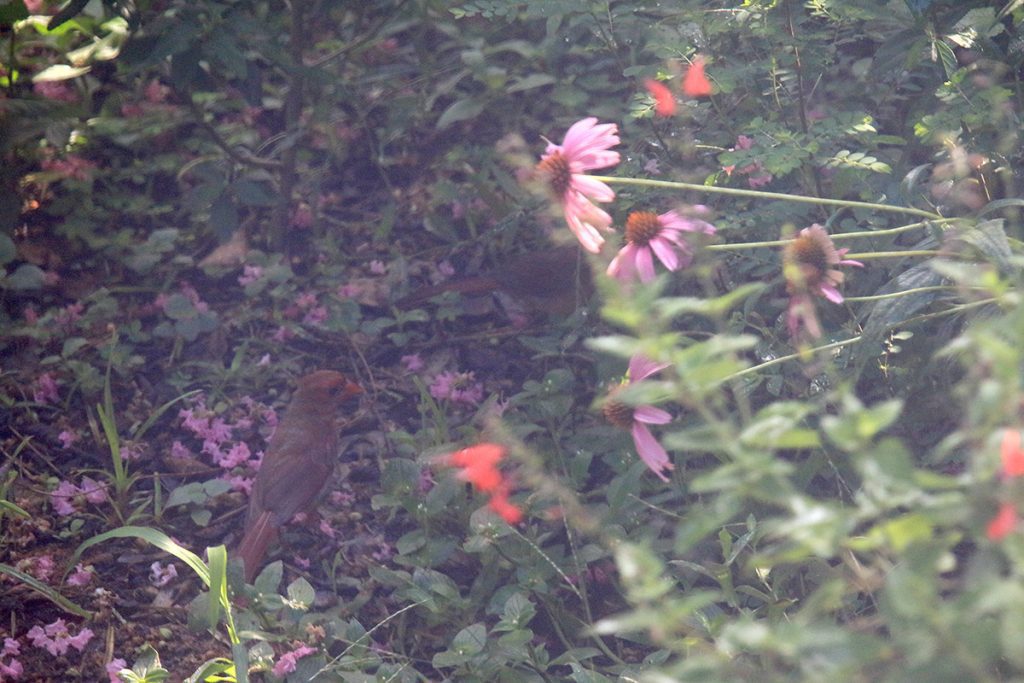
I shot this through a screened window. Unfortunately, they flee when I enter the yard. But I keep seeing different animals there:
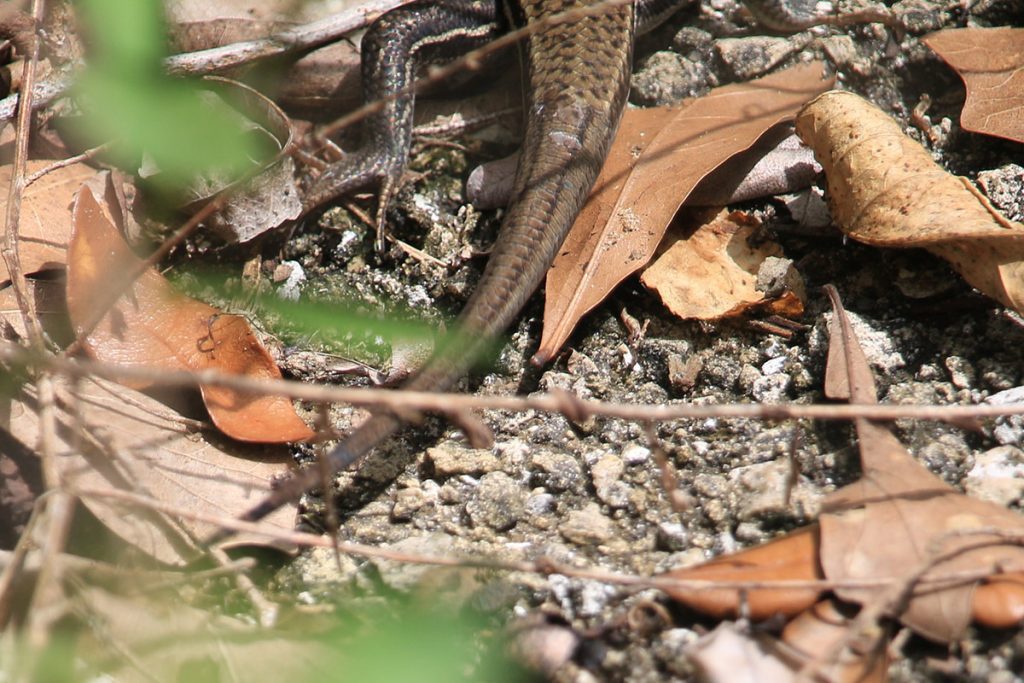
This guy was constantly on the move on the other side of the fence from the flower bed. It finally had enough of me following with a camera and ran into the bed (only to scurry under the house when I circled back).
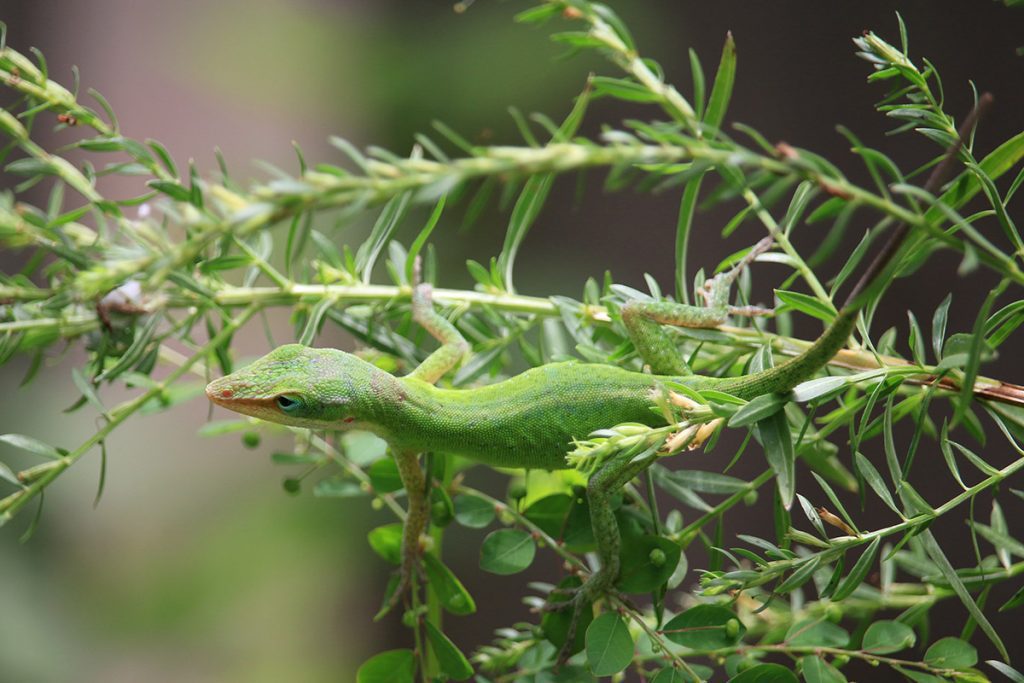
It takes a lot of insects to feed all of these animals. We have a wren nest, and recently fledged cardinals. All of those pollinating wasps need caterpillars, too. We have reptiles, and, when it rains a lot, we’ve had frogs. Insects are the animals at the bottom of the food web. If that layer of the food web isn’t robust, then the layers above it won’t be either. And so those pesky moths that infest our yard with pest caterpillars, they end up feeding animals that maybe we like a little better.
Another reason to like having these moth caterpillars in the yard? It might just keep birds away from the caterpillars I like.
A busy time for caterpillars in the yard
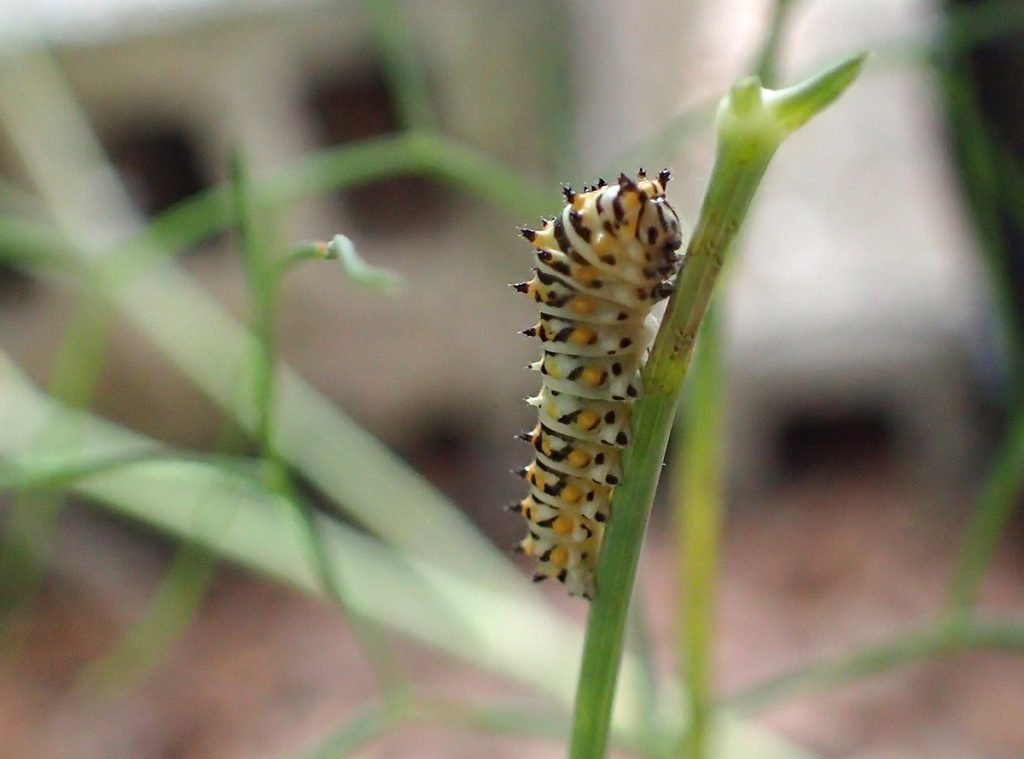
The three black swallowtails I first spotted in June had moved into their third instar phase when I took the photo above. The day after I took this, they were all gone. I saw a little bird poop on the side of the pot. The birds and wasps get the caterpillars I like, too.
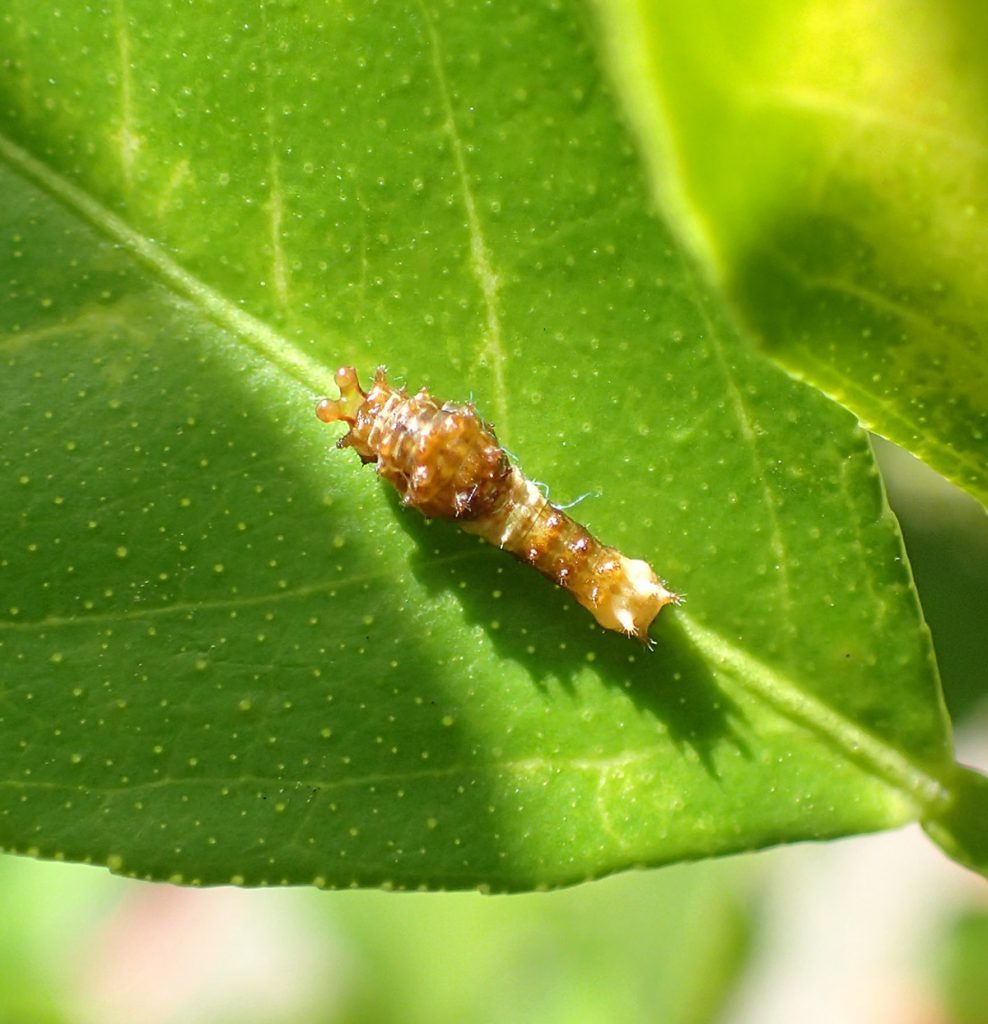
Here’s a caterpillar that seems to have a higher survival rate than monarchs or black swallowtails. At least in our yard. As I cover in our butterfly raising guide, giant swallowtail caterpillars have a few defenses. One is their poop-like appearance. I’m embarrassed to admit that I’ve been excited to find what I thought was a giant swallowtail, only to take a closer look and discover that I was excited about bird poop.
Another defense is the chemicals they secrete when sticking out their tongues, like it’s doing here. I’d never seen the tongue of a first or second instar- it gets more red and snake-like later on (another defense). To see photos and video of that behavior, check out this post.
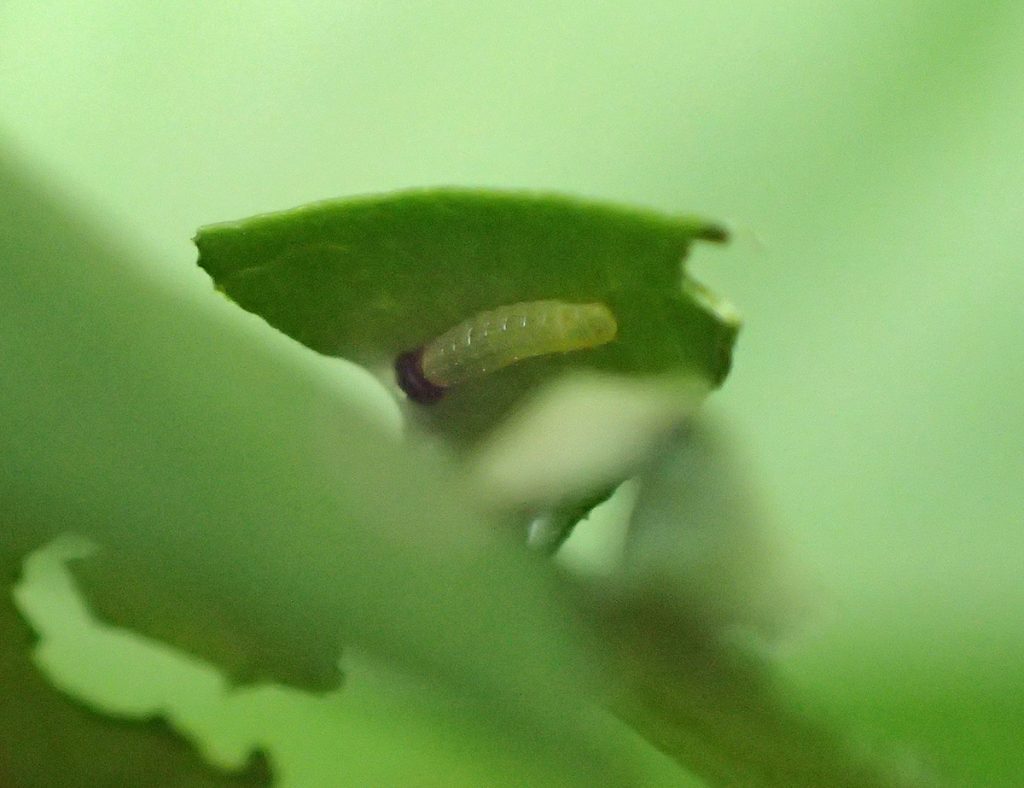
During daylight hours, I’m more likely to see evidence of long-tailed skipper caterpillars than I am to see the caterpillars themselves. At this early instar stage, they make little tents for themselves on bean plant leaves. Older instars will roll the leaves over themselves, earning them the name “bean roller.”
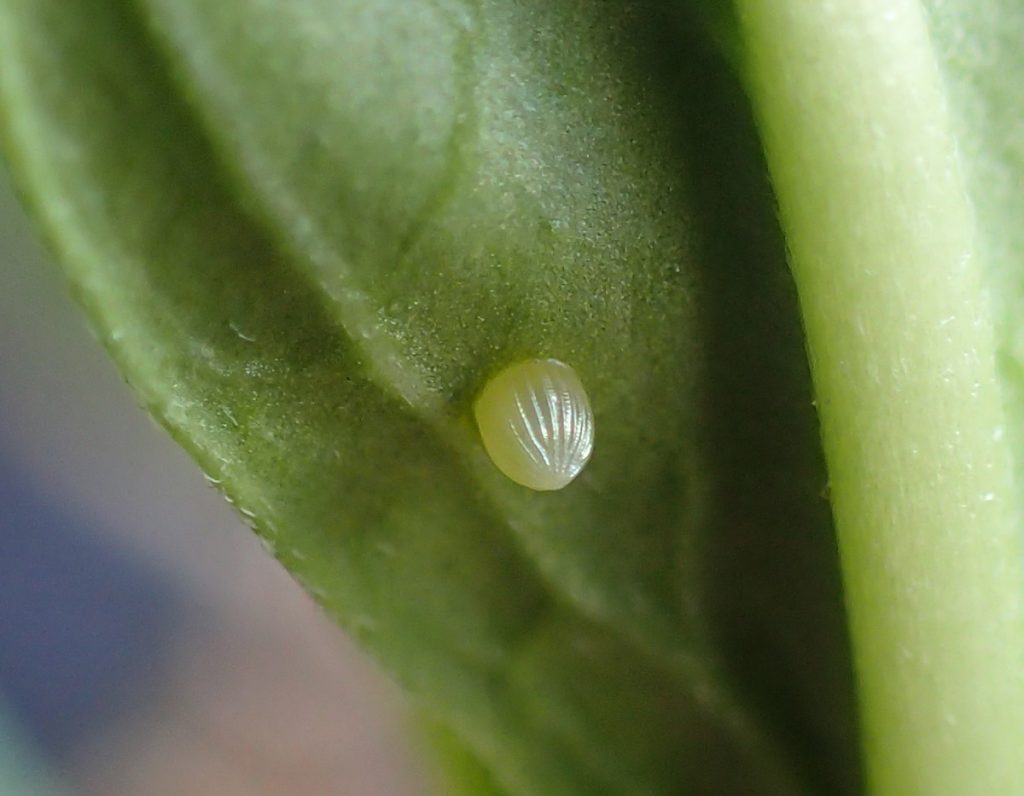
I observed monarch 15 eggs on July 20, which I reported to the Monarch Larva Monitoring Project. That’s 35 eggs observed in 2019. I seem to miss eggs now and then, or maybe I sample too infrequently. I counted ten eggs on April 13, and then had nineteen caterpillars a week later. It’s been another busy year for monarchs, even if I can’t seem to find where a lot of them are making chrysalides.
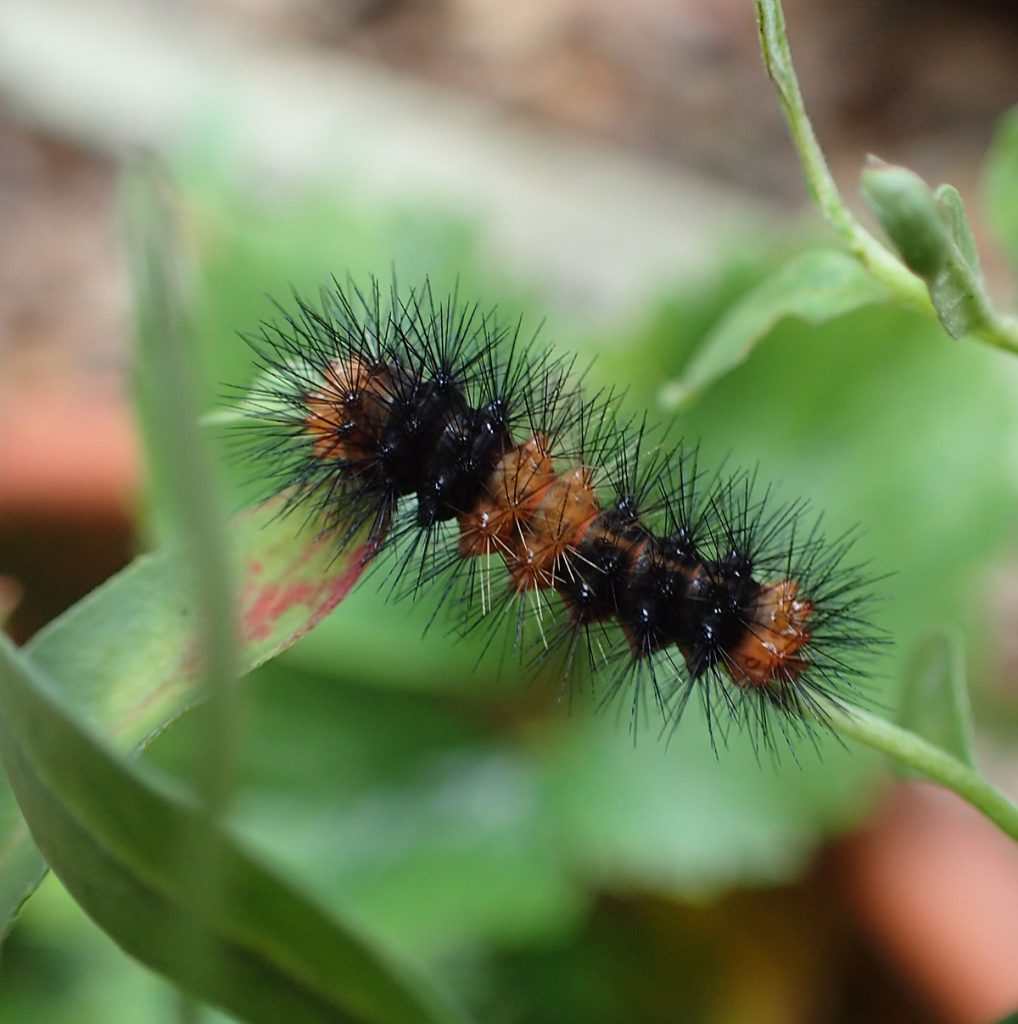
Another generalist moth caterpillar, which I’ve seen on a variety of plants in the yard. This is a younger instar of a giant leopard moth caterpillar; you can see in a photo from the May Backyard Blog how they get much thicker and fuzzier looking. I looked up the moth, and it’s cool looking, but I’ve never seen one. Which is odd, because I so often see the caterpillar.
Is it a weed, or a valuable part of the habitat?
That’s the real question, isn’t it? I like to let a lot of plants grow in the yard, but I’ve been taking a closer look this year. In February, I made the choice to let several non-native plants live because they had redeeming qualities- they hosted butterflies, fixed nitrogen, etc.
In July, we had a mixed bag of uninvited plant guests.
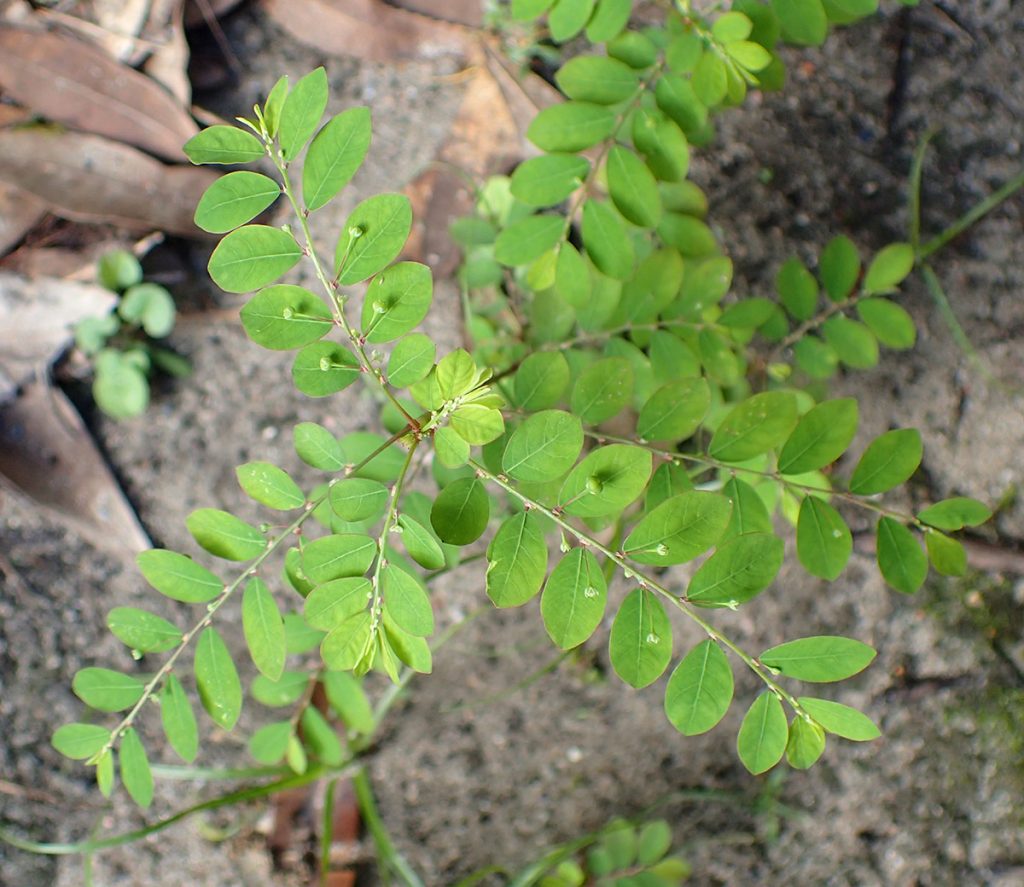
This is chamberbitter, and it grows everywhere. It’s not native, and it’s kind of invasive. Taking a closer look, it’s easy to see why:
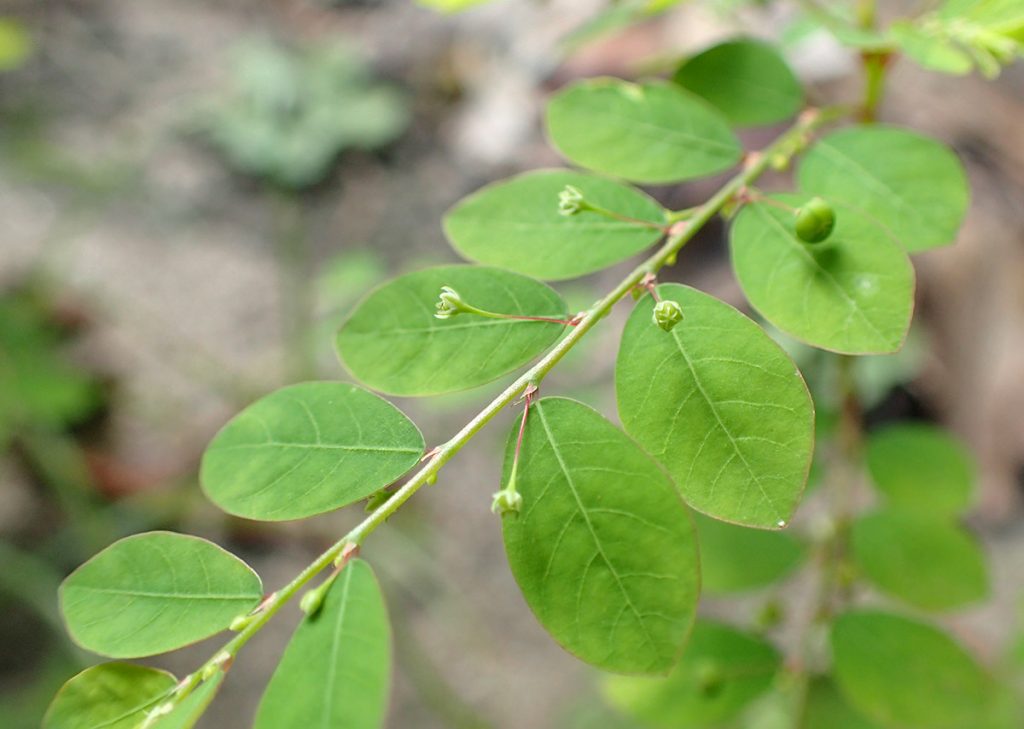
So many seeds! This had colonized a lot of the area where I pulled up he pavers, along with Florida pusley (which I like), and this plant:
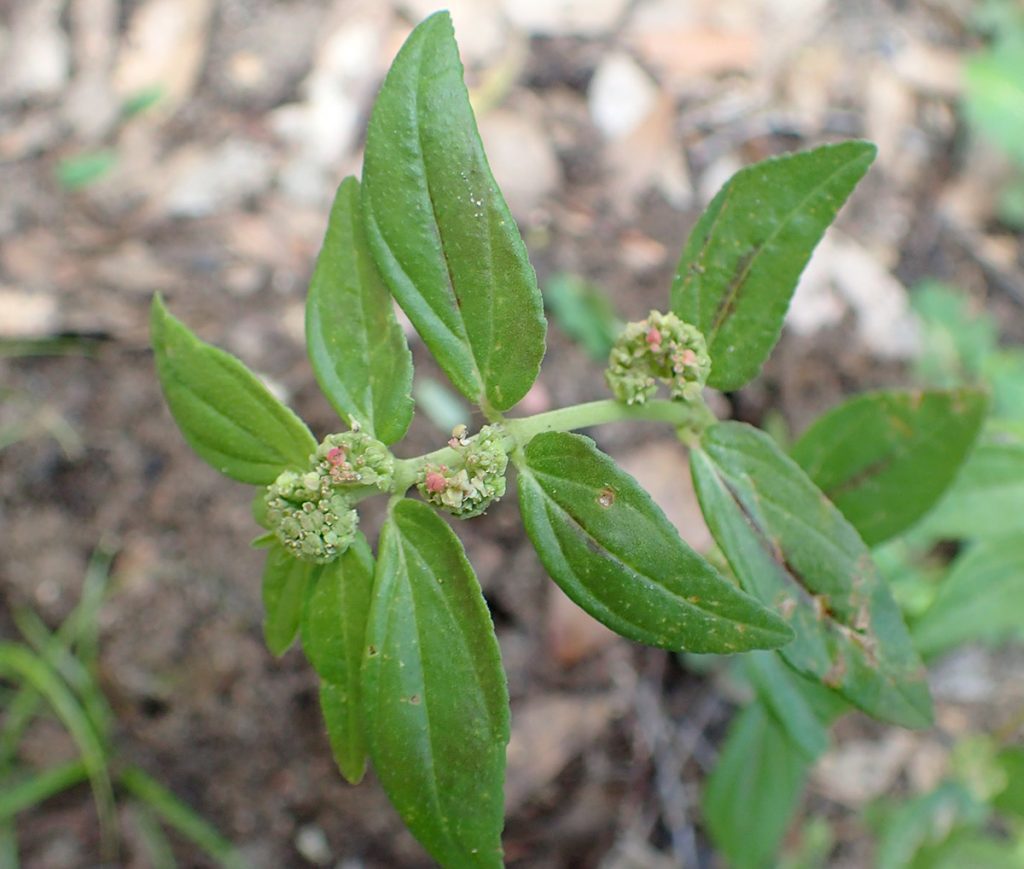
This plant is found in tropical climates across the world. I’ve seen different articles claiming that it’s a central American native, or possibly that it’s from India. It’s used medicinally in Africa and Asia, to, as the name suggests, treat asthma.
Currently, I’m letting the asthma plant stay and pulling the chamberbitter. I want vegetation to cover the ground, just to keep the yard from getting dusty (or, in the rain, muddy). I went to Native Nurseries to buy some native ground cover plants: turkey tangle frog fruit, and a sensitive plant. Both will vine out and spread over time, and both flower. They’re tough and able to take a mowing. I’ll gradually remove the asthma plants as these other plants spread.
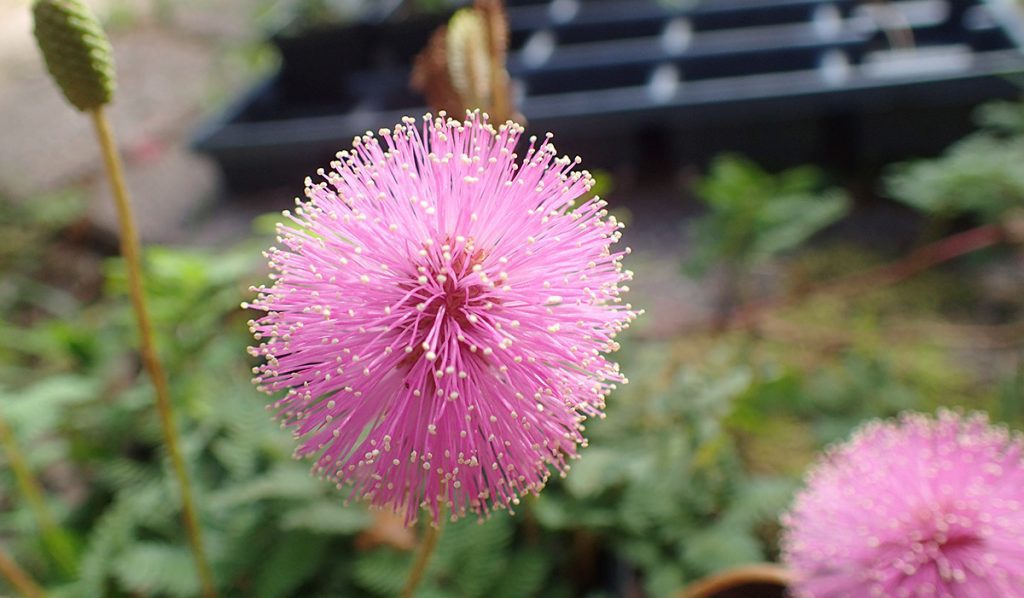
I’ve iNaturalized these little pink flowers in the Apalachicola National Forest, Fred George Basin greenway, and in Louisiana on vacation this summer. I like the possibility of pink powder puffs covering my yard.
Aside from ground cover plants, the increased space in our yard has allowed me to let a few plants grow into shrubs. Two are of interest to me:
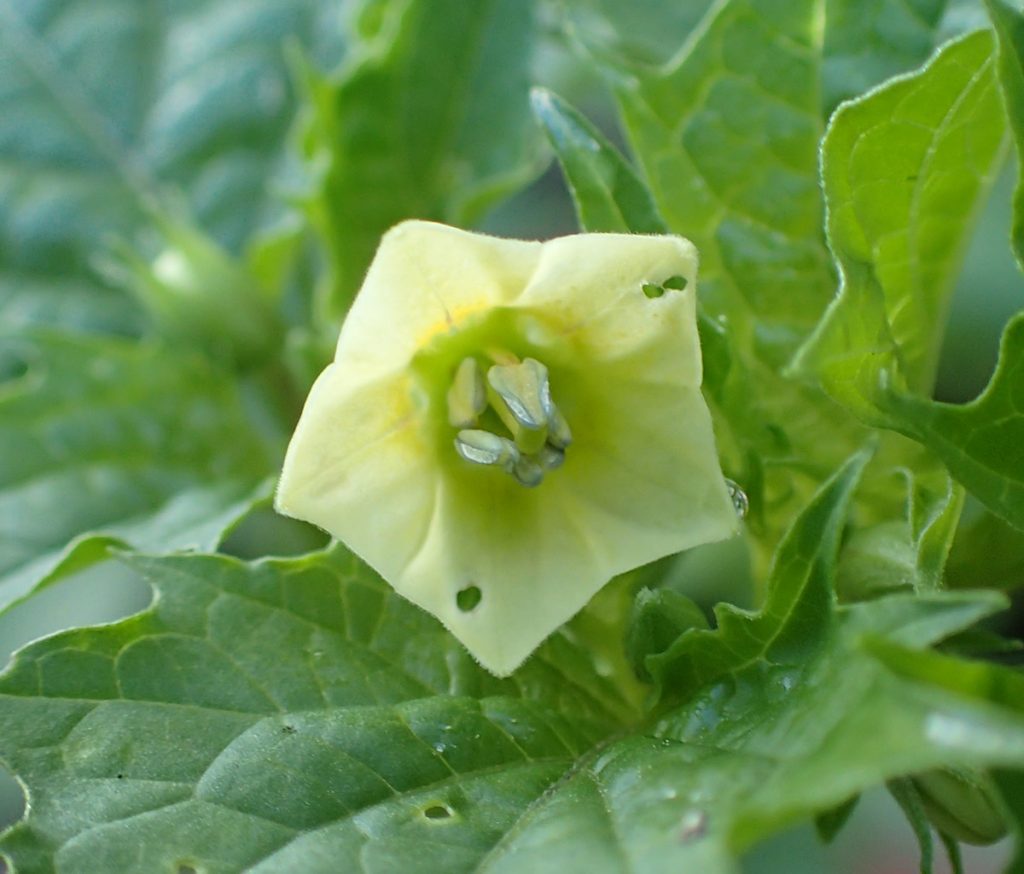
I have a few of these spike-leaved plants in different spots in the yard, and they started flowering mid-month. The initial iNaturalist ID is that this is a groundcherry, the Physalis genus. This genus includes tomatillos, and when you see the husked fruit, you’ll see a resemblance.
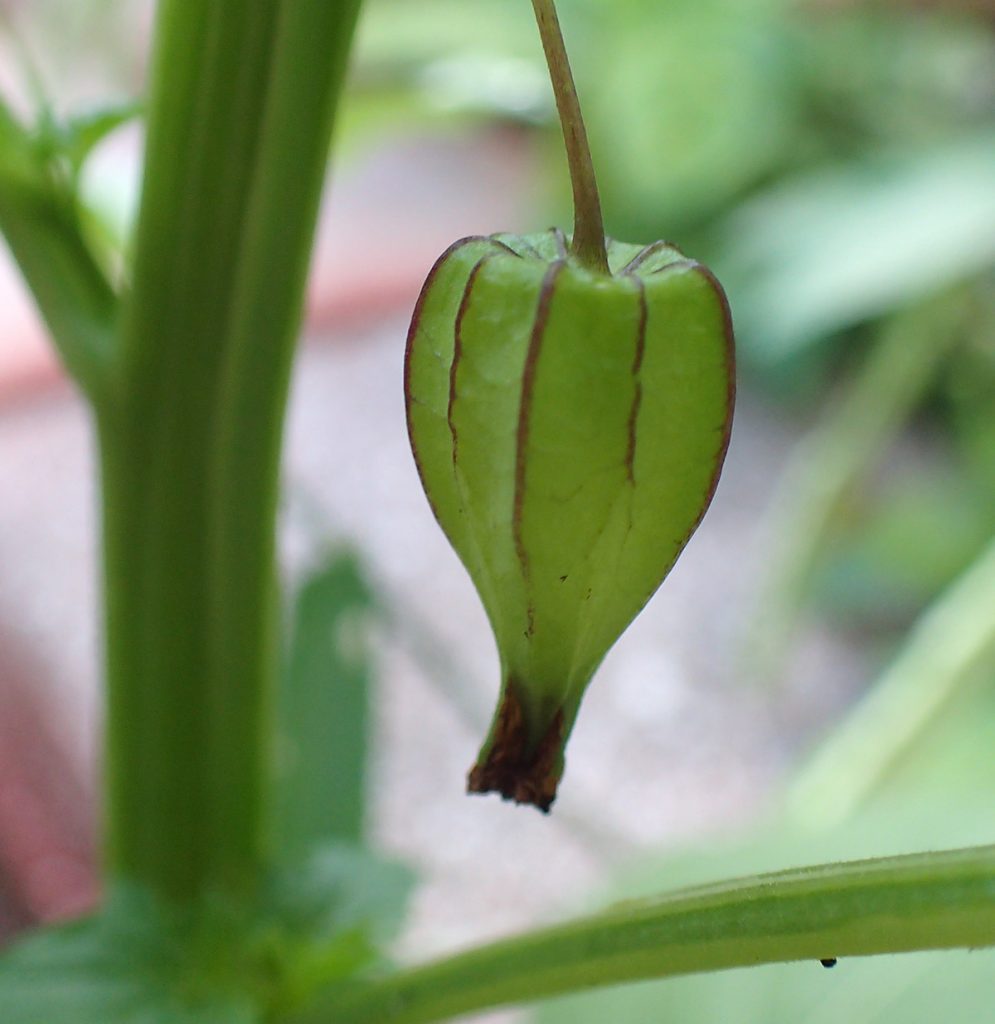
An iNaturalist user left a comment that it was either Physalis cordata or angulata. It didn’t have any fruit when I made the observation, but the commenter said that cordata would be “strongly 5-angled,” and that angulata would have ten ribs. Now that it has fruit, I can count ten ribs. Researching further, I see that angulata has an edible fruit, with the texture of a tomato and the flavor of a strawberry or pineapple. I look forward to trying it!
Here’s a better perspective of the whole plant:
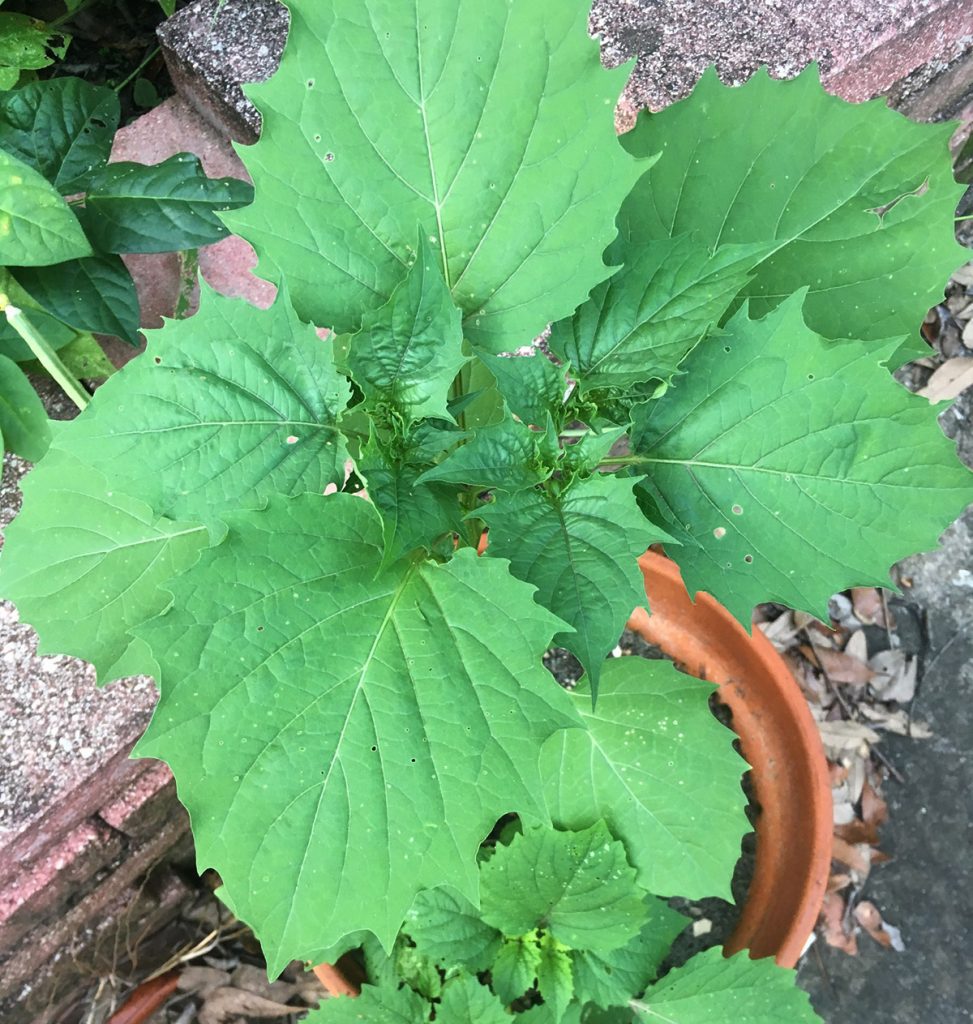
It volunteered into that pot, so another iNaturalist user made it a casual observation, which is how cultivated plants are classified.
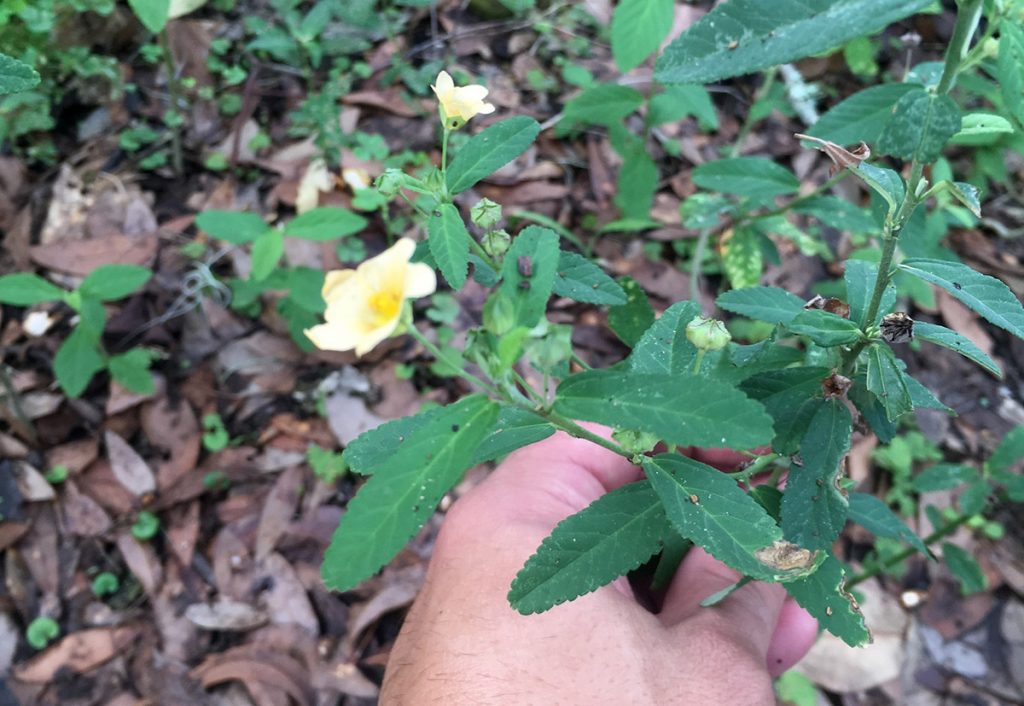
Here’s a plant native to the southern US and into Mexico. It has a few common names, such as Cuban jute, Queensland hemp, and Indian hemp. The Sida genus is larval food for checkered-skippers, like the one I’ve found in our yard. So that’s something to keep an eye out for.
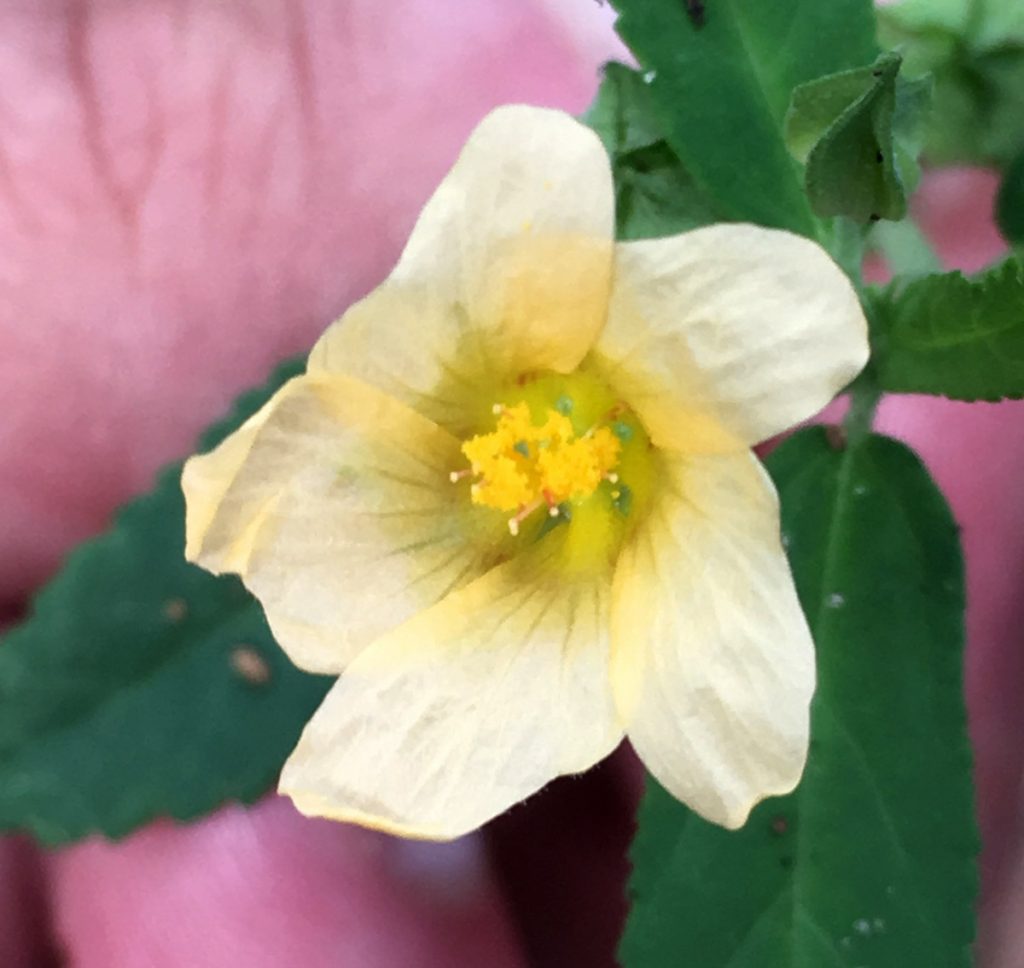
I have seen a butterfly or two nectar on the flowers, though it’s not as popular as the salvia, coneflowers, or loosestrife. The thing to watch for with this plant is that it does get kind of large and woody. It grows in several spots in the yard, so I have to decide if I want to keep all of the plants.
Odds and ends
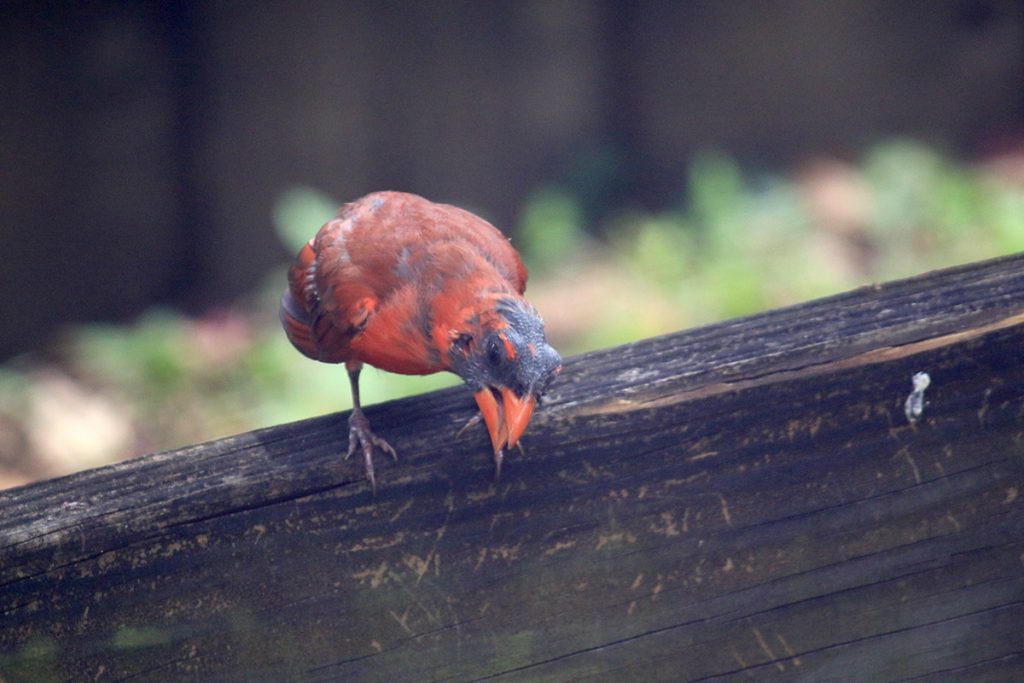
At first I thought this was one of the juvenile cardinals molting into its adult feathers. But evidently, they molt their feathers every summer.
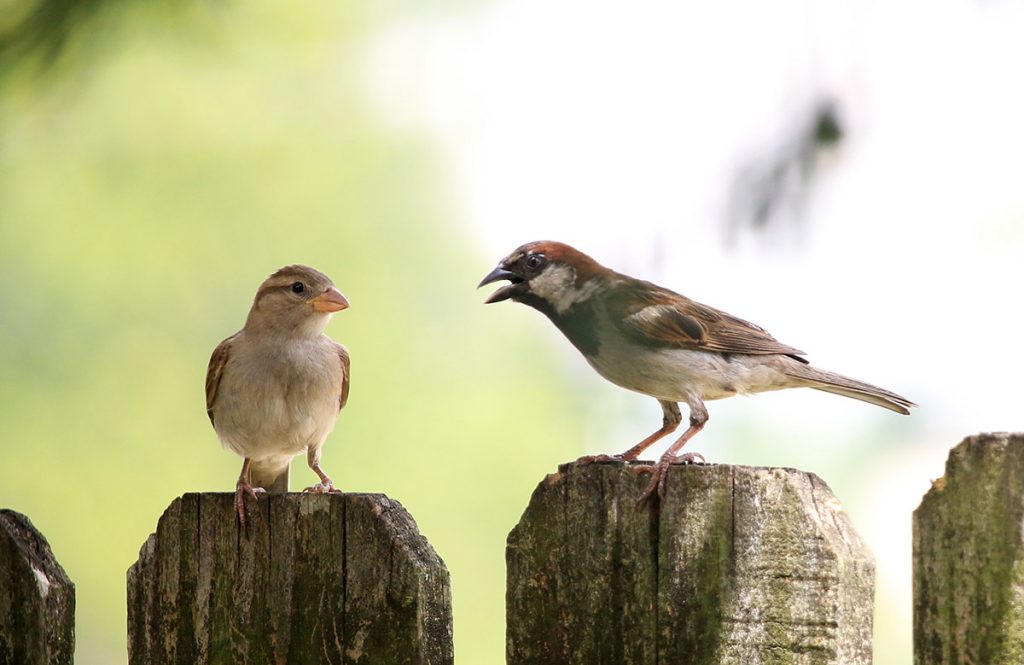
While we were on vacation this June, our bird feeder went empty, and the flock of house finches that swarmed it every day had gone absent. A few days after replacing the seed, we had a flock of house sparrows. Both are non-native to our area. House finches are native to the Western US, but were introduced in the east and spread out. House sparrows are European.
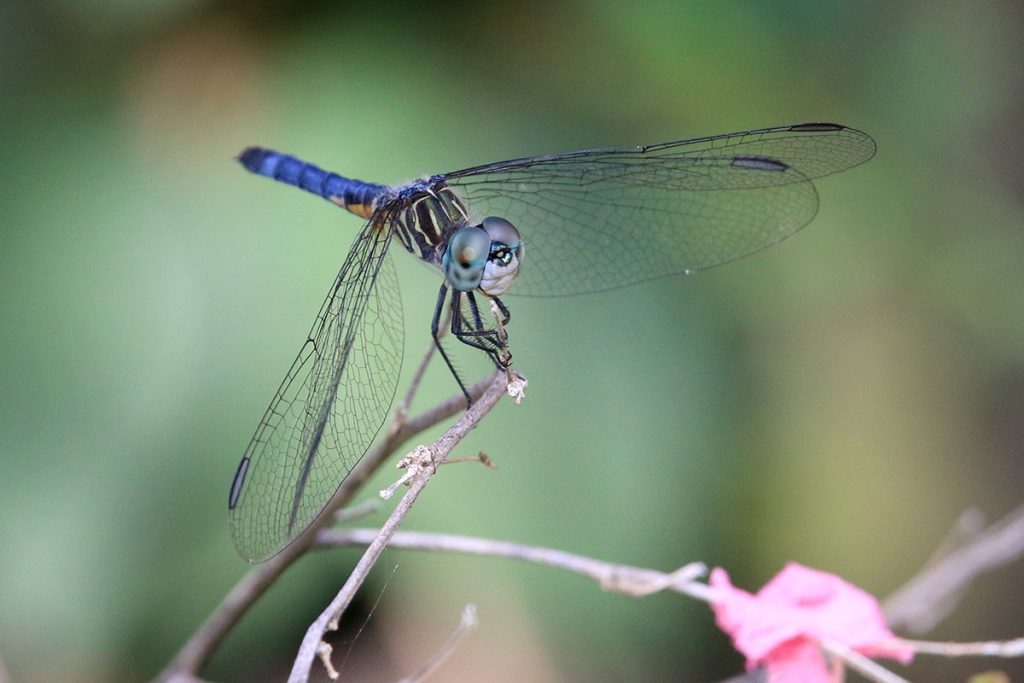
This dragonfly is not far from the bird bath, where mosquitos breed. Dragonflies hunt mosquitos, which we love. This is a blue dasher, which is common throughout our area. I iNaturalized a few of these during the City Nature Challenge.
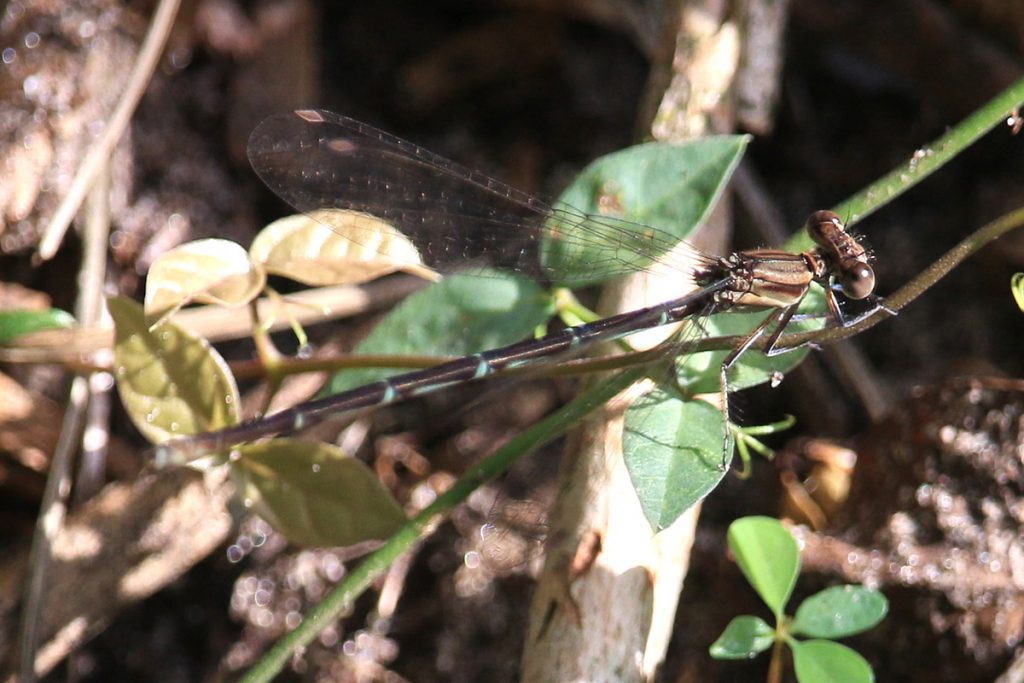
This is, based on my initial iNaturalist observation, a blue-ringed dancer, a type of damselfly. There is a similar looking blue-tipped dancer as well, which has more observations locally. But the blue-ringed has also been observed in other parts of north Florida and south Georgia. Honestly, some species aren’t heavily observed on iNaturalist, so you can’t go entirely with its range maps in determining species. But it is a good tool to springboard you into further research.
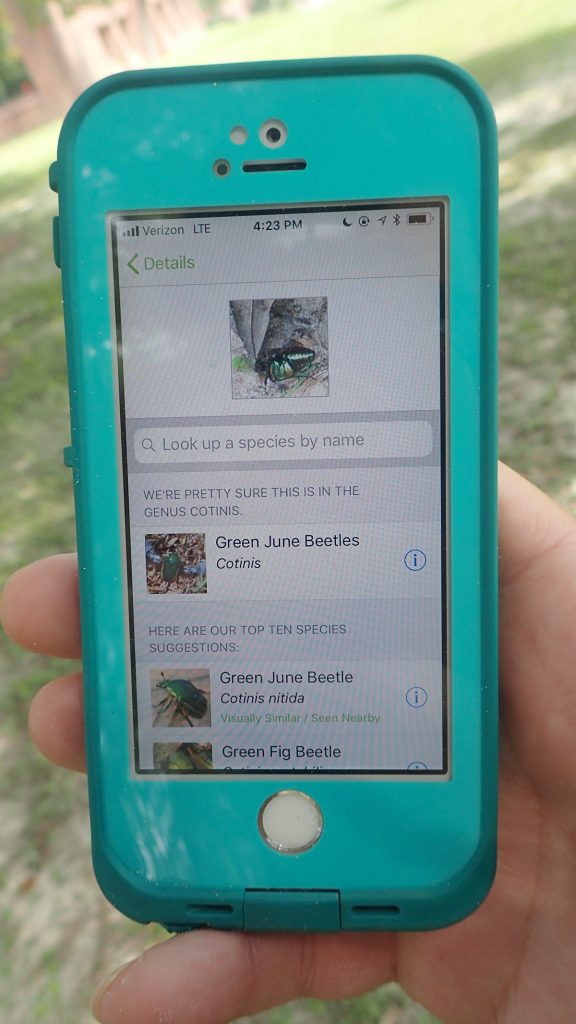
Apps and Citizen Science mentioned in the Backyard Blog
iNaturalist
Identify plants, animals, lichens, and fungi in your yard. Other users correct your identifications if you’re wrong, and even if they don’t, it can be a good springboard to further research.
Seek by iNaturalist
Instant identification, and it doesn’t record your location. This is a good option for kids with phones.
Monarch Larva Monitoring Project
Enter information about monarch caterpillars in your yard, and help researchers get a sense of the health of the monarch population that year, and how and when they’re migrating.
Great Sunflower Project
Record the number of pollinators visiting your flowers, and help researchers map pollinator activity across the country.
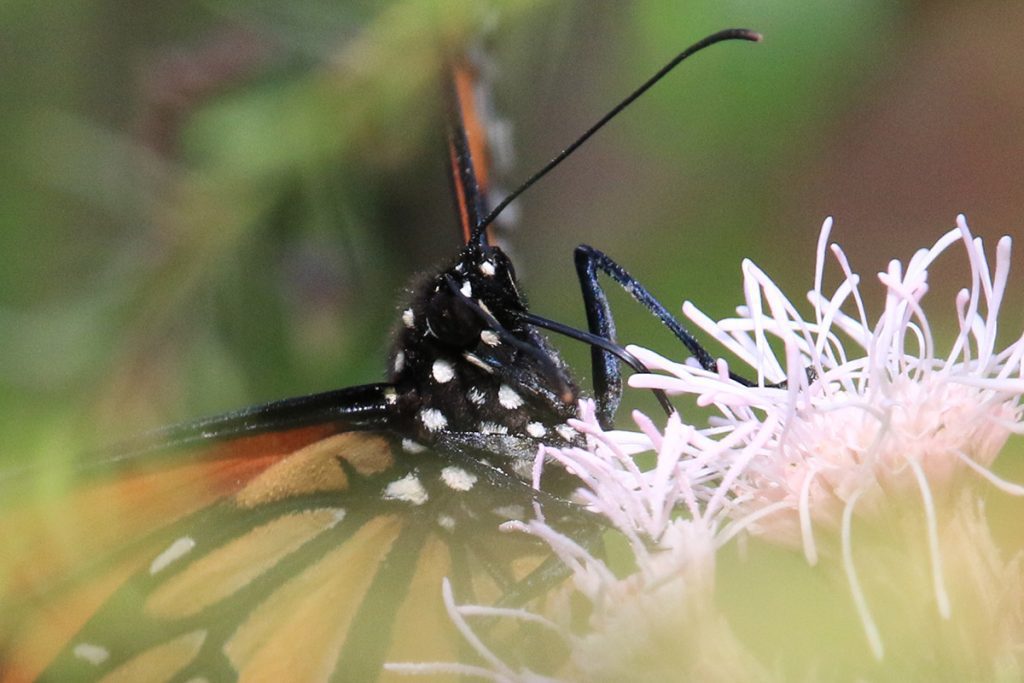
Dig Deeper into Backyard Ecology
What can we do to invite butterflies, birds, and other wildlife into our yards? And what about the flora and fauna that makes its way into our yards; the weeds, insects, and other critters that create the home ecosystem? WFSU Ecology Blog takes a closer look.

